
|
Home DH-Debate 32. Erik Lam 34. Valdemar the Great |
The killing of Knud Lavard in 1131 in Haraldsted Forest north of Ringsted started a civil war, which in fact - with breaks in between - came to last for 26 years. At the death of Erik Lam in 1146, the smoldering animosity flared up, and the fighting largely lasted for 11 years until the Battle of Grathe Hede in 1157, when Erik Emune's son, Svend, fell, and Valdemar became sole king in Denmark. After his death, Svend was bynamed Grathe after the place where he fell.
The problem at King Erik's death in 1146 was that there were as many as three talented royal princes, who were candidates as king. They were Svend, son of Erik Emune, Knud, son of Magnus the Strong and Valdemar, son of Knud Lavard, who, however, was quite young at the time.
The Battle of Fodevig and Erik Emune misdeeds were not forgotten. Jutland and Funen had supported King Niels and his son Magnus the Strong and they preferred Magnus' son Knud. The eastern part of Denmark, which had supported Erik Emune to some extent, preferred his son, Svend, whom posterity has given the byname Grathe.

|
Denmark's county tings in the Middle Ages. It is seen that the Northern Jutland ting in Viborg represented by far the largest area. Photo Vesconte2 på Wikipedia.
Since Harald Hen was appointed king in 1074 after his father Sweyn Estridson, the great men of the kingdom had succeeded in agreeing upon only one candidate at each royal election, thus avoiding divisions and civil wars. The procedure was in all likelihood that they gathered at Iseore or some other central place and agreed on which royal prince they thought was best for the country. Then the chosen one was formally hailed on the county tings, one after the other. Much indicates that he was first hailed on the Jutland Ting in Viborg, which represented Northern Jutland. After being elected in this large and important area, he had a good argument on the following tings. Moreover, Jutland was the original area of the royal line, which was conquered by "Hardegon, son of a certain Sven", who established himself in a part of Jutland around the year 917. Many bards pay tribute to the Danish kings as Jutlanders' kings.
Helmold says that when Erik Lam felt that death was near, he recommended Erik Emune's son, Svend, as king, that Svend, who later should be bynamed Grathe: "As Herik felt his last hour approaching, he summoned the three young princes and determined, following the advice of the chieftains, Svejn to king, and told Waldemar and Kanut to satisfy with their ancestral heritage; and when he thus had brought this in order, he departed."
But Knud did not accept the dying king's recommendation: "But immediately Kanut Magnusson violated the last will of his guardian, tried to seize the royal power and fought Sveno with all his might. Waldemar joined the last one, and the whole Danien came into turmoil. Great signs appeared in the northern part of the sky, appearances resembling fire torches and red human blood. And the predictions spoke true because everyone knows how great a loss of lives this particular terrible war caused."

|
Timeline - based on royal genera - which illustrates the history of Denmark. All Danish kings, with the exception of one, descent from "Hardegon, son of a certain Sven", who conquered part of Jutland around the year 917, as told by Adam of Bremen in the section of Hoger. But it is advantageous to divide the list of kings and thereby Denmark's history in some manageable groups or dynasties because it gives a good overview.
The Knytlings have their name from Hardecnudth, most likely son of Hardegon. He is called Knud 1. and was probably the father of Gorm the Old as told by Adam in the section of Unni. Magnus the Good was the son of the Norwegian Saint Olav the Holy; his reign forms a transitional period into Sweyn Estridson and his sons and grandsons time. Sweyn Estridson was the son of Sweyn Forkbeard's daughter, Estrid.
The rivaling kings, Svend, Knud and Valdemar were all princes who descended from Sweyn Estridson, but their time nevertheless constituted a transition period into the Age of the Valdemars.
Most historians include only Valdemar the Great, his son Knud 6. and Valdemar Sejr in the group of the Valdemars. But no one can have a patent on those definitions, and I suggest including also their direct male descendants - including Erik Plovpenning, Abel and Christoffer 1. - until Christoffer 2. - in the group of the Valdemars, thereby allowing to divide the line of kings into manageable dynasties.
Valdemar Atterdag was not King of the Union, but it was his grandson Oluf 2. His daughter Margrete 1. became the reigning queen of the Union of Scandinavian kingdoms. With some good will, you can say that Valdemar Atterdag rebuilt Denmark, thereby laying the foundation for the Scandinavian Kalmar Union.
The first Oldenborg kings were also Union kings, but only for shorter periods.
The Civil War, the Count's Feud, took place at the same time as the Lutheran Reformation, and it was a crucial turning point in the history of Denmark. As a result of the Reformation, it became possible for the kings to take possession of the third part of the arable land of Denmark which had belonged to the church. This immense wealth made it possible to push the old nobility aside and establish the absolute monarchy, which was a major cause of Denmark's historic decline. A democratic Constitution was introduced in 1848 without bloodshed.
The Oldenborg line became extinct in 1863 with the childless Frederik 7. The throne was then taken over by Christian 9. of Glücksborg.
Neither Saxo nor Knytlinge Saga knows anything about Erik Lam's recommendation. After his death in 1146, the chieftains' agreement on the process of the royal election collapsed and the country fell into chaos and civil war.
Knytlinge Saga recounts simply that Svend was elected in Skaane and Knud in Jutland: "King Erik Emune's son Svend was in Scania chosen to be king after King Erik Lam; but the Jutlanders took Knud, the son of Magnus the Strong Nikolausson to the king.
Helmold has only scorn left for the Danish chaos: "In these three, the Danes had still fresh royal subjects, so they could always be kept in practice, so that they would not get out of the habit of fighting and thereby, eventually vanquish. For it is only in civil wars they show strength."
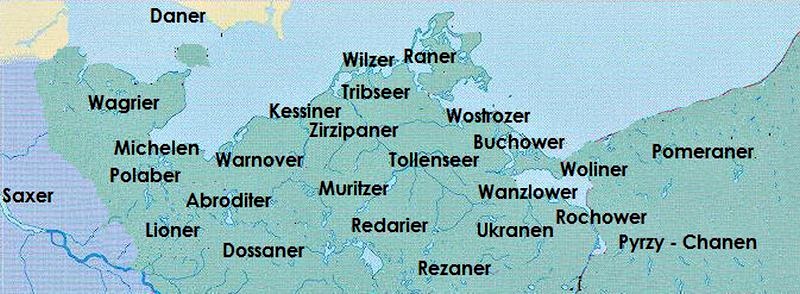
|
Map of the the land of the Slaws, called Venden, showing the various Slawic tribes and peoples.
The priest from Lubeck believes that the mistake was that all these young men from childhood had been told that they were royal princes and predetermined to become kings: "and these heirs to the throne were brought up with royal honors, a circumstance that should be the cause of future wars and the downfall of many Danes."
Saxo says that Svend was elected on Sjælland and in Skaane, but not without protests. A man named Olaf Stam objected that it was wrong to choose a separate king only for Sjælland, he believed that the ancient procedure should be followed, which was that the chieftains of the whole kingdom gathered in a central place and agreed upon a common candidate: "When Erik was dead, people could not agree on who to choose as king, because Knud Magnusson eagerly sought election in Jutland and Svend Eriksson on Sjælland, and the first one was favored by his grandfather's, the second one by his father's merits. While Svend now begged for the votes of the Sjælland people, and most of them were also willing to vote for him, there was a man by the name of Olaf, bynamed Stam, who eagerly held on to what was customary in the past, and cursed everyone who gave Svend name of king, and besides also him, in case he accepted it, for he could not accept, he said, that in this case the whole authority of the kingdom was compromised, or that a man should be granted royal dignity, without all common people of the whole of the Kingdom solemnly had accepted."
Throughout the 11-year-long final phase of the civil war, the Slaws ravaged and plundered along the Danish coasts and on the small islands, killing many thousands of inhabitants or carried them away as slaves. There was no royal power strong enough to effectively contain them, even though Svend made a wholehearted attempt, among other places on Fyn and nearby islands.
Helmold's Slawic chronicle tells that Svend was the son of Erik Emune and a woman named Thunna: "Herik became king in Danien and fathered with his mistress Thunna a son named Svejn." Some suggest he was born in 1125, which sounds very reasonable.
One can think that he was the son that Erik Emune initially forgot to bring with him when he fled his Norwegian captivity in 1133.

Svend Grathe's portrait on a coin. He calls himself Sveno, which he also is called somewhere in Helmold. The portrait is not so successful, but he seems to be clean-shaven. Photo Facebook.
In his youth, Svend served in the Emperor's Life Guard. Saxo says: "Svend had, in his young days, served in Emperor Konrad's household troops to learn the science of war, and there he had long served together with Frederik, who at that time was no more important than he, and who was equally old with him and also otherwise his equal." Frederik later became emperor, bynamed Barbarossa, and Svend met him again in 1152 in connection with the Emperor's mediation in the Danish civil war.
In the last year of Erik Lam's reign, 1146, he returned to Denmark, where he and his cousin Valdemar, despite Archbishop Eskil's objection, placed Knud Lavard's bones in a holy shrine, though he had not yet formally been declared a saint.
Apart from the failed joint crusade against the land of the Slaws in 1147, Svend is the only one of the three kings mentioned in the written sources, who made an effort to protect Denmark against the Slaws. Saxo talks down his efforts, but his own hero, Valdemar, first took the initiative against the Slaws after the civil war: "To subdue them, Svend repeatedly attacked the whole of Venden, but without much luck, for he was impatient and hot-tempered enough to attack, but did not have enough endurance in the fight." And elsewhere: "When Svend now felt that he was safe from danger on Knud's side, he took charge of guarding the Kingdom against external enemies. In several places on the coast, which by nature were well fortified, he erected defense ramparts for the protection of the peasants. At the Great Belt, he built two fortresses, one on Funen and the other on Sjælland, but the Slaws are said to have destroyed both of them."
Svend won the Fyn people's respect and gratitude for his uncompromising fight against the Slawic invasion: "He fought with them on Funen, where the Danes fought with great bravery and felled so many of them that most of his warriors had their skin worn out on the hands, so that the fingers sat in the bloody flesh, as the Swordhandles had worn on them."
He tried to persuade others to fight the Slaws. "When the king now realized that it was going downhill with the kingdom and that it was already almost destroyed, but that he could not, with his own powers, defend it against the pirates, he believed that the wisest thing he could do was for money to buy help against the Slaws from Duke Henry, who at that time was exceedingly mighty. He promised him three thousand marks of silver as a payment for his help and raised the money by public fundraising. However, when Henrik, whose friendship was not as useful as easy for sale, had received the money, he only kept promise to little extent compared to what he had promised, whether it was because he would not or because he could not."
Knytlinge Saga also reports on Svend's fighting against the Slaws: "King Knud and Valdemar left for Jutland the same day, but King Svend returned to Roeskilde. In the morning, King Svend fought with the Slaws at Kalvlunde, and had victory and killed many people."

Statue of Svend Grathe in Nordborg on the island of Als. Photo Wikimedia Commons.
Svend was king subject because he was the son of Erik Emune. But the same father's bad reputation also made it difficult for him. The Danes largely identified him with his father. They had not forgotten the battle of Fodevig and Erik's murder of Harald Kesja and eleven of his twelve sons.
But Svend did not have the father's fanaticism and cruelty. In many cases, he showed gentleness and forgiveness towards his enemies. When he conquered Viborg in 1151, he captured a large number of Knud's people but allowed most of them to redeem themselves. Saxo says: "When King Svend came to them, Bishop Elias of Ribe, after judging them all, said that the King ought to act as a gardener, moving up the harmful plants so that the useful ones may prosper. It sounds grim, but when you think more carefully, you have to admit that it was very well considered words that briefly but cleverly expressed what was important. If Svend had followed his advice, surely no hope would have been left for his rival, but though he could have punished the prisoners for what they had done to him, he was let by his innate gentleness to treat the prisoners gently. Most of them he allowed to redeem themselves, some he allowed to swear allegiance to him, and others he allowed to guarantee him loyalty. Only two of them he punished with their lives.
When he conquered the main town of Ditmarsken in 1152, his father's killer, Plov, was among the prisoners, but Svend let him go. Saxo says: "The townspeople, who were completely finished by the many wounds and by fatigues, since they could never have time to rest and care for their wounds, and who received no relief, now gave up hope and surrendered to the king. He proved far more honest and gentle towards them than they thought he would be, and even to Plov, who had killed his father, Erik, he showed special grace, for he did not punish his father's killer, but held that he should take more into account that he had surrendered according to his honest promise than to his vengeance. Neither did he punish any of the others, neither with death nor captivity, but released them without ransom; it did not matter as much to him, he said, whether they were with or against him; for people who had so often been unfaithful and broken their oath, could not be followed by any luck."
However, Knytlinge Saga tells in two places that Svend's man, Yngve Kvaisa, later killed Plov.

Coin with portrait of Svend Grathe found at Oster Uttrup. He may have a skipper's beard. We see the text "Sveno Rex". Foto Pinterest.
Helmold recounts that when Svend returned with the emperor's help in 1156, he refused to burn and ravage the country to force the men of the country to deliver battle as was customary. Helmold - who is generally quite negative towards Svend - writes: "Surely, Svejn often had bragged for the duke that he was sure that the Danes would receive him with open arms as soon as he appeared at the head of an army. But this presumption did not work at all. For in the whole of the land of the Danes there was no one neither welcomed nor greeted him. Therefore, when he noticed that luck had turned its back to him and that everyone was avoiding him, he said to the duke: "Our effort is wasted; we should turn around again! Because what benefit do we have from ravaging the land and plundering honest people? No matter how eagerly we want to meet our opponents in battle, we can never succeed, as they flee before us and escape over to the more remote parts of the sea."
Svend did not think of himself as infallible, he was wise enough to discuss his plans with advisors and rely on the advice of others when he found them good. Saxo says: "But when he traveled over Fyn (perhaps in 1149), he received the news that Ebbe Skjalmssøn had died. He became so depressed that he brought his army back to Sjælland again and gave up the intended attack, for he preferred to mourn the warrior he had lost rather than to fight with his rival. For there had been such a great friendship between him and Ebbe that he did not do anything on the ting or in the field without consulting him, and both when it was about his own affairs and the affairs of the kingdom, he completely followed his opinion."
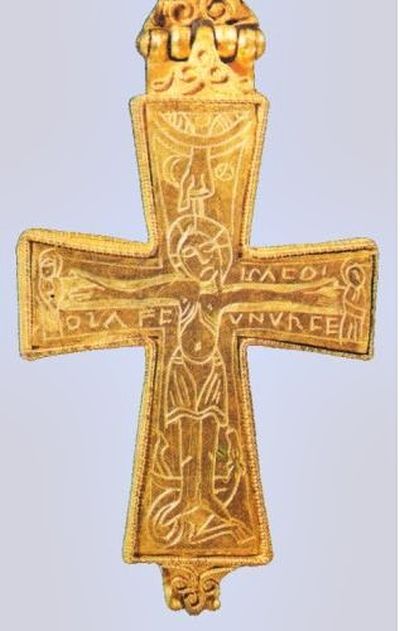
The Orø Crucifix is also called the Margrete Crucifix after the finder. It is manufactured in Scandinavia in the 1100's. It is a so-called relic cross made in two parts with a cavity in the middle. On the front side is the crucified Jesus, who is trampling the pagan dragon underfoot. Above his head is God's right hand between sun and moon. To the right and left of Jesus' arms are two small figures, presumably Mary and John the Baptist. Along with his arms are the words OLAFC VNVnCE which means Olaf King and ISACO. The cross was found in 1849 on the island of Orø. The cross and the associated chain are made of 22-carat gold. It is 8.3 cm high. Photo Orø Kirke - Fritze Lindahl.
Knytlinge Saga thinks that it was no good thing that this advisor died, as he was replaced with others who had a more hard-boiled view of how Svend should win the whole of the kingdom: "King Svend then went after King Knud to Fyn, and offered him a settlement; but when he came to Odense, his counselor, who was the uncle of Absalon, who later became Archbishop, died. King Svend, therefore, traveled back and remained passive on Sjælland that winter. Then Ribe-Ulf came to King Svend as advisor, and Ditleif Edlarsøn and Yngvar Kveisa, thereby greatly increasing his animosity."
King Svend had respect for reality and was not desperately over-optimistic, as one might suspect his father to have been. Time and again Saxo uses phrases about him like: "When Svend now doubted of being able to remedy the disaster, he abandoned the dangers that threatened from the pirates, and instead aimed to secure himself against the country's own children", "When Svend got news, that he had come, he doubted that he was strong enough to withstand him, and went to Viborg, which he had recently fortified, and decided to endure a siege there.", "Svend had never before felt greater mistrust in his happiness, but when he saw that his enemies voluntarily separated themselves from what they should benefit from in the battle, his discouragement turned into the most joyous hope." and "Svend, who did not trust the war luck very much and was afraid of exposing his horses to danger, exhausted the enemies by attacking them from the sides"
It is said that in 1152 Svend married Adele of Meissen, who was the daughter of Conrad, the Count of Meissen and Lausitz, and his wife Luccardis. Saxo says: "However, he was prevented from doing so by his impending marriage, for he had recently been married to a daughter of Duke Konrad of Saxony and was now going to have a wedding with her." It is said that with her, Svend had a son, who died as an infant, and a daughter named Luccardis.
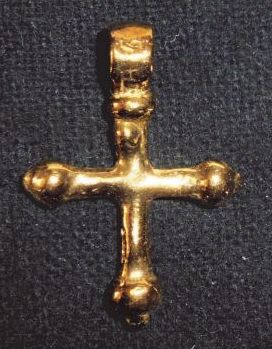
Museum copy of hanging cross found at Grathe Heath, where on 23 October 1157 Valdemar defeated Svend Grathe. The cross is of silver and has originally been gold plated. It is 3 cm high. One must think that it belonged to one of the fallen. Photo Blicheregnens Museum.
Svend fell in the final battle of the Civil War on Grathe Hede at Thorning northwest of Silkeborg and south of Viborg in 1157. Saxo says that he was totally exhausted: "Even he was leaning on the shoulders of his men, he eventually became so overwhelmed with fatigue that he ordered his companions to escape and placed himself at the root of a lone tree that stood on the battlefield, for his power failed him to such an extent that he could not even drag himself away supporting against others." It fits with that he - still according to Saxo - during his conversation with Valdemar in Sct. Albani Church in Odense confided him that he was seriously ill: "He himself was so ill, he said, that he could hardly live for another year, and he had no sons that he should seek to give the kingdom."
Knud was the son of Richiza of Poland and Magnus the Strong, who was the son of King Niels and played a significant role in the first phase of the civil war - from the killing of Knud Lavard in Haraldsted Forest in 1131 until the Battle of Fodevig in 1134. Magnus was elected king in Västgötaland around 1120, but he is best known for the killing of Knud Lavard. The murder that triggered the long-lasting civil war in Denmark.
Magnus was a beloved and respected leader figure in the fight against Erik Emune, he was especially loved in Jutland. Roskilde Chronicle bursts into tears over his death in the Battle of Fodevig: "Woe to the day when Magnus is killed, Denmark's flower is broken; he, the most beautiful among the young, handsome, and powerful, a happy giver, wise, and a lover of firmness; Magnus is killed, and with him chieftains and five bishops."
Many warriors wanted to serve Magnus' son.
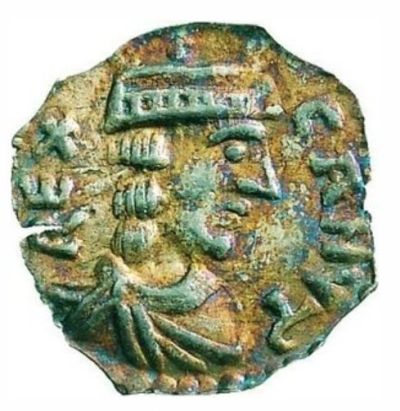
Coin with a portrait of Knud Magnusson. Der står Cnudt Rex. Perhaps he was - like his father - a physically large man. Photo Wikipedia Commons.
After the Battle of Viborg - perhaps in 1151 - Svend let most of the prisoners walk away provided that they swore that they would not fight against him, but many nevertheless later returned to Knud when he came up through Jutland with a German army, Saxo says: "Confident in this promise, he went into Jutland with an army of foreign warriors, and neither the mercy and goodness that Svend showed his people nor the consideration of the hostages or the fear of being accused swearing false prevented his old warriors from coming to his banner."
After Svend's victory in Ditmarsken, also around 1151, he let the defeated go free provided that they swore not to fight him. But many broke their oath and went back to Knud: "When they were released, they went to Knud in his exile, for he was so much held by his men that no one ever became sorry to serve him, no matter how he fared."
But Knud had not inherited his father's leadership qualities. The Jutlanders chose him as king in 1146, probably because of his father's merits, but he had an anxious personality, which did that he, in the long run, did not meet the expectations in the role as a king. One must think that is why after a few years they chose to supplement him with Valdemar.
Saxo describes Knud's excessive caution in many places.
Shortly after Erik Lam's death, Knud had agreed with Archbishop Eskil in Lund to land in Skaane with an army at the same time as Eskil rebelled against Svend, but for fear of betrayal, he did not dare to go ashore when he really came to the coast of Skaane. Saxo writes: "Knud, who did not trust in his promise, however, did not want to let his people go ashore, but was, before he came, plunged into the sea again to return to Sjælland."

|
The blood feat in Roskilde. Valdemar and Knud sit on the left and play chess with Svend Grathe on the right. Knud leans anxiously up the more manly Valdemar. Image from Niels Bache's "Nordens Historie" from 1886.
At the battle of Tåstrup shortly after the failed joint crusade against the Slaws in 1147, the Jutland chiefs did not allow Knud to participate: "Knud was not allowed by his people to take part in the battle, whether it was because he was so young or because they would not expose him to the danger of the battle, so instead of leading, he had to look to."
Around 1155 Svend returned from Germany to the island of Fyn and was enthusiastically received by the Fyn people - whom he had previously defended valiantly and uncompromisingly against the Slaws."Crowds of men and women flocked to him from everywhere to fight for him." Saxo writes. Knud and Valdemar ordered leding in Jutland and eastern Denmark against Svend and the Fyn people but did not attack, as it would not look good to attack Fyn, who had already suffered a lot during the Slaws' plunder. Instead, they began negotiations, but Knud did not want to participate in fears of treason: "When he went to Odense the next day to bathe, which Knud did not dare to take part in for fear of treason, he was received by Svend, who would like to win his friendship, with a solemn procession of clerks who met him with the saints' shrines."
Due to his father's popularity and more direct royal descent, Knud was a more obvious royal choice than Valdemar. One can think that Saxo was Absalon's and Valdemar's man, and they had an interest in talking Knud down to make Valdemar the natural choice. But it is likely that it was the Jutland chiefs, who wanted Knud to give a third of his wealth and his sister in marriage to Valdemar to make him change side. It must be because they were not happy with Knud and lacked a clever and competent leader of royal descent to support him. Furthermore, Valdemar must have been interested in switching sides, because he probably could not dispute Svend, as this was loved and respected by his men and supporters. There were much greater opportunities in the Jutland camp, precisely because Knud was an anxious and fearful personality.

|
Hoje Taastrup Church behind the trees. In 1149, the kings Knud Magnusson and Svend Grathe met in a battle below the hill on which Høje Tåstrup Church is located. Photo Tanja Mikkelsen Google Maps.
Valdemar was the son of Ingeborg of Novgorod and Knud Lavard. Together they got three daughters and eventually a son, who, however, was born seven days after the father's death, which makes it possible to pinpoint his date of birth very accurately, namely January 14, 1131. The name Valdemar came from Ingeborg's grandfather, Vladimir, the great Prince of Kiev. He grew up in the care of the Sjælland chieftain Asser Rig and thus became the foster brother of his sons, Absalon and Esbern Snare.
Knytlinge Saga says that he was a beautiful man: "Early he became both pretty and big and very good in most things."
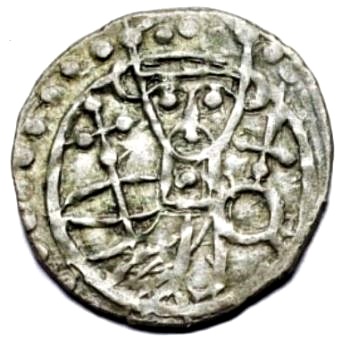
Valdemar the Great on a coin. When Valdemar later became sole king he issued this coin. The portrait is supposed to represent himself.
The Civil War started in 1131 because of Magnus the Strong's killing of Knud Lavard in Haraldsted Forest. This must have aroused some attention when, in 1153, Valdemar surprisingly switched sides from Svend's party to Knuds - the son of his father's killer. Some must have considered what the meaning of the Civil War chaos really was.
His political change was by all accounts after cool calculation; because the opportunities for one day to become king were greater in Jutland at Knud, than they were at Svend in Skaane and Sjælland, as it became gradually obvious - even to Knud's supporters - that Knud had difficulties living up to the role as king. Valdemar did not become overly suspicious of Svend - because he knew him. As Saxo writes in connection with that Valdemar and Svend talked together with no other present on the island of Lolland in 1156: "As Valdemar used to associate with Svend more confidentially."
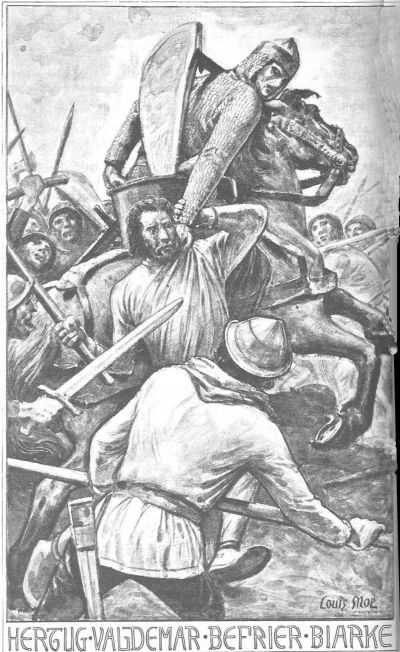
Valdemar rescues his friend Bjarke from a difficult situation in the first battle of Viborg. Drawing Louis Moe.
Valdemar was by all accounts personally brave without being foolhardy.
Saxo says that in the Battle of Viborg, where he was still on the side of Svend, perhaps in 1151, he saved his friend Bjarke out of a difficult situation, as he was surrounded by enemies and could not see because of sweat that ran down into his eyes. Saxo says: "Bjarke thought it was an enemy coming rushing, and went loose on him with the ax, but Valdemar grabbed him and anticipated the blow, he only got a violent blow on the shoulder by the shaft of the ax; but it was with difficulty and scarcity that he managed to get him out."
In an episode in a later battle at Viborg, the people of Svend and Valdemar's were separated from Knud's German warriors by a small stream with a very swampy bottom. Valdemar found a ford. Saxo says: "On the other hand, four men with their lances hit him so hard in the middle of the stream that his horse sat on its behind, but he was such a good rider that he did not fall off. A fifth man pushed his lance in between his helmet and forehead where it remained, but he struck it loose with his sword bracket and pulled it out" Next, Valdemar and his men secured a bridgehead on the other side of the stream.
He was intelligent and calculating, so to understand that he did not take unnecessary chances - he did not mind waiting until the right time before he took action. He first engaged himself in battle with the enemy when he thought he could win and when the enemy was weakened as much as possible.
Knytlinge saga tells: "Valdemar had a son out of wedlock by the name of Christopher; his mother's name was Tofa." It must be the famous Tove from the folk song."
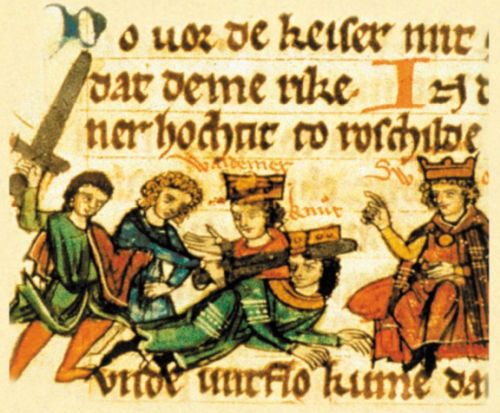
The blood party in Roskilde in the old handwriting Sächische Weltchronik from the 1200's.
After the blood party in Roskilde in 1157, Valdemar managed to escape and return to Jutland. It quickly became known that Svend had ordered leding in his part of Denmark intending to attack Valdemar in Jutland. Still, Valdemar took the time to marry his fiancee, Sofie, Knud's sister, to demonstrate his allegiance to Knud's cause and win supporters, even though Knud was now dead. Saxo says: "However, Valdemar, who considered it uncertain what outcome the fight would have, returned to Viborg, where he celebrated his wedding, partly to make it easier for those who had fought for Knud to support him and partly so that the enemies could not deprive his beautiful fiancée of her chastity."
As mentioned, Valdemar married Knud's half-sister, Sofia of Minsk. Sofia was the daughter of Magnus the Strong's widow, Richiza, and Prince Volodar of Minsk, a descendant of Vladimir of Kiev, just as Valdemar was. After the Civil War, Valdemar became the sole king of Denmark, and together they had eight children.
When Svend had landed in Djurså in Jutland in 1157, Valdemar's people succeeded in persuading the Sjælland people to sail home, thus weakening Svend before the battle. But he still did not feel confident that he should have victory. Saxo says: "When Valdemar was told by him that the enemy was advancing, and he still thought that he did not have enough fighting power to face the enemy in battle, he commanded the bridge leading to the city to be broken of." This is confirmed by Knytlinge Saga: "King Valdemar then crossed Randers bridge, and would not yet enter into battle, as he waited for a still more people. But when King Svend came to Randers, King Valdemar had the bridge cut off, and he could not cross the river." Later Saxo says: "Finally Valdemar, whose army grew with each passing day, got the courage to engage in battle and decided to pass the river in another place and attack the enemy."
Erik Lam, in his time, appointed Eskil, the son of Asser's brother, to Archbishop of Lund, which was the only one of his actions in which can be traced a contradiction to his comrade in arms, Erik Emune's decisions. Eskil incurred the dislike of Erik Emune by instigating a rebellion on Sjælland in 1137. Erik turned down the rebellion and gave Bishop Eskil a monster fine of twenty marks gold.
Presumably Eskil, now Archbishop, has always regarded Erik Emune as a usurper and tyrannical ruler, and it follows that his son, Svend, then could not have a very strong claim to the throne.

Romanesque dice chapter in Sjørring Church. The animal must surely be a lion. Photo Henrik Bolt-Jorgensen.
Therefore, it was quite natural that in 1146 Eskil secretly agreed with Knud, whom he must have regarded as the true king, that they should correct this regrettable error. They agreed that Knud should come to Skaane with an army, and then Eskil would join him and together they would choke Svend's royal status at birth. Saxo writes: "With confidence in the Jutlanders, Knud now went over to Sjælland to take charge of it, and by secret promises, he lured Archbishop Eskild to make him fall from Svend, on whose side he had hitherto been standing. The archbishop then also allowed himself to be persuaded and told Knud by his envoys that he should come to Skaane with his fleet, then he would join him."
Eskil's scouts told him that now Knud had come, and "with waving banners he galloped with his riders down to the shore". But Eskil had not taken into account Knud's anxious and suspicious mind. Saxo continues: "However, Knud, who did not trust his promise, and did not want to let his people go ashore, but had, before he came, put to the sea again to return to Sjælland." Now Eskil was facing Svend alone, revealed. Saxo continues: "As the archbishop suddenly left town, Svend followed him, and when he turned around, he gave battle and overcame him."

Eskil as a prisoner in St. Laurentius Church Tower. Drawing Louis Moe.
Initially, Svend put the archbishop under arrest: "As there was no dungeon in the city, he was hoisted up into the tower of St. Laurentius Church, so the church became his prison." But Svend soon realized he couldn't afford to have an archbishop as an enemy: "However, when Svend became afraid that he would be excommunicated for that matter, which is the worst punishment a bishop can give someone, he not only released him from his prison but also gave him a village and a much of Bornholm to make him his sincere friend."
Then Svend went to Sjælland, where Knud stayed. They met in a battle at Slangerup, where Svend prevailed. Saxo says: "Then, without him, he delivered a bloody battle against his rival at the village of Slangerup, overcame him and drove him away from Sjælland." Knytlinge Saga says the battle took place at Thorsteinstorp (perhaps Taastrup). Knud fled back to Jutland.
In the year 1146, all of Europe was in turmoil over the sudden conquest of one of the results of the Crusades, the County of Edessa, by Muhammadans. Both Louis 7. of France and Emperor Conrad 3. of Germany took the cross this year to recapture Edessa.
Some felt that there were enough unbelievers nearby, that was not yet turned to Christianity, and therefore they did not have to look for such in distant lands. On a grand meeting held by the Emperor in Frankfurt in March 1147, Bernhard of Clairvaux agitated first to solve the Slawic problem. The Slaws should be reversed at all costs or completely destroyed. He persuaded the Pope, Eugenius 3. to send out a declaration which promised those who took the Slawic cross the same sin-forgiveness and blessing that those who went to Jerusalem got.
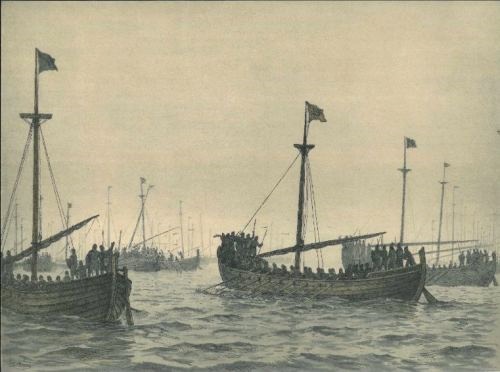
The Leding fleet. Photo Hastati Danorum.
Knud and Svend now agreed to keep peace among themselves and together go towards the Slaws. Saxo says: "For now not to neglect their Christian duty over their domestic struggles, the Danes took the cross and obeyed the Pope's commandments. Knud and Svend gave each other hostages, ceased their hostilities, for a time made peace to do something better and decided to use the swords, with which they had hitherto strived for life each other, to fight against the enemies of Christianity." Eskil was a great admirer of Bernard of Clairvaux and exchanged letters with him; one can see his hand behind the peace agreement.
The total Danish leding, from both east and west, now in 1147 headed against Venden, "- while the Germans, by agreement, made an attack from another side." Saxo continues: "The Jutlanders and the Slesvig people anchored in the hostile harbor, the first ones under Knuds, the second under Svend's leadership. The Sjælland and the Skaane people came last and anchored where they could best fit around the part of the fleet that had come first."
"Now the city of Dubin, notorious for its piracy, was besieged by the united armies, as all the Danes went shore with, with the exception of a few, who remained to look after the ships." Apparently, the city of Dubin was on the mainland, it's not known where, but one can guess Bad Doberan, formerly called Dobran.
But the Slaws from the island of Rugen took advantage of this opportunity to attack and destroy the fleet. Saxo says: "When the Rugen people learned how few they were, they decided to begin providing the beleaguered assistance by doing away with the enemy fleet. They attacked the Skaane fleet, which had anchored most far from the shore, and chopped down nearly all of them. The Jutlanders, who guarded the ships and were not very numerous, looked on passive: "The Jutlanders rejoiced the slaughter of men among the Skaane people, for they did not count them as comrades in arms, because they did not have the same king as them; for they had not yet forgotten the battle of Fodevig, and the hatred which had recently been between them was still alive in their minds."
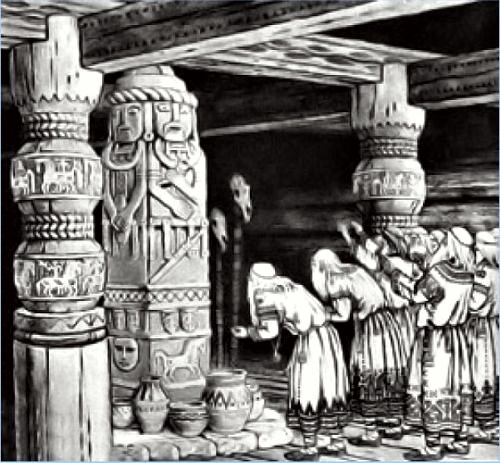
Reconstruction of Svantevit worship in Arkona on the island of Rugen. Photo Tårnborg Grundejerforening.
After some time, the Danes who besieged the city were told what had happened. They returned and displaced the Slaws. Saxo gives a grim description: "However, the Danes, who besieged the city, received news that the pirates had overcome their fleet, they then went back, took the ships they found intact, drove the Rugen people, who did not dare to resist, out of the harbor and avenged thus the defeat, their comrades in arms had suffered, by chasing the enemy on the run, although it was hardly possible for them to make their way over the sea because of corpses."
After this episode, the siege of Dubin disintegrated.
Also between the Saxons there was disagreement, since they had come to the realization that it was their own taxpayers they fought. If they destroyed the Slaws, they would no longer be able to pay the usual taxes to the German princes. Helmold says: "But among our Duke's men, and among Count Albrecht's men, they said to one another: "The land that we plunder is it not our own land, and the people we plunder are they not our own? Why then should we be our own enemies and destroy our own wealth? And will these losses not fall back on our masters?"- And from that day they began to drag their feet and be sloppy with the siege, and there was often a cease-fires. For every time the Slaws were beaten in a skirmish, the army was held back so it should pursue and take their camp."
Helmold continues: "Eventually, our people grew tired, and it was agreed that the Slaws should accept Christianity and release the Danes they had taken as prisoners. But many of them only pretended to be baptized. Then they let all the old and useless go, but retained the rest, those who had the age and strength to serve them."
The Slaws robbed and looted, certainly - but mostly at the Danes. Helmold concludes: "Thus, this mighty army campaign ended in poor yield. And soon it got even worse, for the Slaws did not care that they had been baptized and did not stop the plundering gangs from ravaging among the Danes." Saxo says no one bothered to check if the Slaws complied with the terms of the peace.
Svend's ship had been taken and a large part of his crew killed by the Slaws. Knud offered Svend to sail him home on his ship, but Svend refused and traveled home over Slesvig.
Soon after returning from the land of the Slaws, the kings began to prepare for new acts of war. Svend improved the defense of Roskilde: "to have a safe base, he surrounded Roskilde, which was not fortified, with defense ramparts and moat" and appointed his trusted advisor Ebbe Skjalmsøn as the leader in the city.
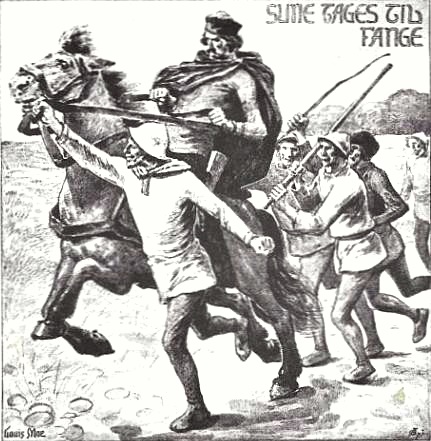
Sune is taken prisoner. Drawing Louis Moe.
Knud believed that Svend had been greatly weakened by the fighting in the Slaw land and he wanted to exploit it: "Knud, who held the defeat, the Skaane people had suffered, a fortune's favor to him and believed his power thus was increased just as much as his rival's was decreased, now would not give Svend time to recover from the loss, he had suffered, and therefore, especially relying on the Jutlanders, went over to Sjælland." He sent an eloquent agitator named Sune to Roskilde to persuade the citizens to open the gates to him. But Sune was grabbed and put in chains and got his eyes stuck out. Then Knud gave up to take the town and sailed home to Jutland.
But quite soon after "he" (Knud) " sailed unexpectedly into Isefiord, captured Roskilde by surprise and burned down Ebbe's house, after he had escaped to Svend."
Some important Jutlanders with big military experience went over to Svend in Skåne on two ships, and together with them and Eskild's forces, he went ashore in Sjælland and defeated Knud in the battle of Taastrup (today Hoje Taastrup) perhaps in 1149. He was first beaten on retreat, but at the urging recommendation of his army commanders he reorganized and with all forces they made a bold counter-attack, and Svend then, to his surprise, saw that he was the victor. Knud did not personally take part in the battle. Saxo says: "Knud was not allowed by his people to take part in the battle, whether it was because he was still so young or because they would not expose him to the danger of battle"
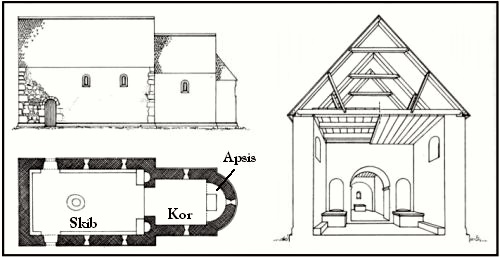
Lay-out of typical Romanesque stone church.
The vast majority of Denmark's village churches are believed to date from the 1100's. They are priceless cultural treasures. It can probably be linked to the introduction of the tithe, but it still shows that it was a prosperous period - the peasants could afford to pay tithing. This regardless of the rage of the Civil War and the Slaws' plunder. Besides, that's probably why the Slaws came - because there was something to take. Within the borders of that time Denmark, in the 1100's, more than 1,750 well-known churches were built in the Romanesque style.
The Romanesque churches are characterized by being low and compact - at least compared to the later Gothic towering style. They have round arches opposite the Gothic, which have pointed. Their floor plan is, with few exceptions, characterized by an almost square choir (possibly with apse) and a rectangular nave. As a general rule, the choir faces east. The baptismal font is located in the middle of the nave.
Erland Porsmose has shown that a strikingly large proportion of the Funen parish churches were located in groups with a mutual distance between 3 and 4 km.
By this time, the young Valdemar joined Svend, which was quite natural as it was Knud's father, Magnus the Strong, who killed Valdemar's father, Knud Lavard, in Haraldsted Forest. Saxo says: "Some time afterwards, the son Knud the holy, Valdemar, who had just reached the age of arms, joined Svend to learn the art of war under him; He did not want to deal with Knud because his father had acted so badly against Knud Duke."
Svend did not hesitate to make him the Duke of Slesvig, as his father had been. Admittedly, there was already a duke in Slesvig, whom Knud had appointed. It was Knud Henrikson, a son of Henrik Skadelaar. As one can figure out there was a controversy that arose between the two dukes, in which Valdemar gradually got the upper hand, probably thanks to the Slesvig people's love for his father. Saxo says: "He (Svend) bestowed upon him the dignity of duke of Slesvig that his father had had, but Valdemar had to endure many battles with a man named Knud Henriksson, who had eagerly sought to be granted this province under Knud Magnusson. Eventually, however, he got the upper hand, but there was just as much controversy between them about this small province as between the kings about the whole kingdom. This allowed Svend to get a foothold in southern Jutland.
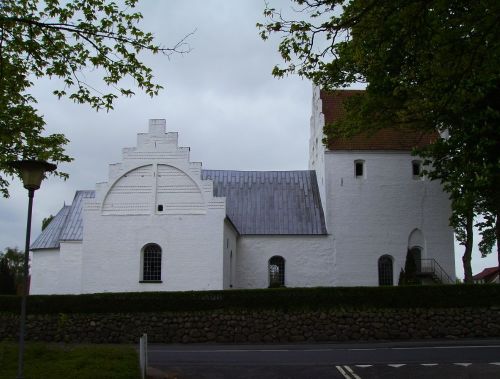
Sanderum Church near Odense is a typical Romanesque stone church from the 1100's with a nave and a choir and later added a tower and some other extensions. Photo Soren Moller Wikipedia.
However, Knud allied himself with Count Adolf of Holstein, thereby endangering Svend's and Valdemar's new possession of Slesvig. When King Svend stayed on Fyn "- however, an outlawed man named Edler came to him and urged him to wage war on the Holsten people," tells Saxo. "Whereby he promised to provide full support of small vessels to transport his warriors over the river, as the Holsteiners had broken the bridge across the Eider of to make access to their land so much more difficult. The king agreed."
Helmold says: "The two kings fought each other to associate our count and sent envoys with gifts. The Count liked Knud best and called him to a conversation and became his vassal. When that happened, Svend became angry, and with an army he went into the land of the Wagrians and set Oldenborg on fire."
However, Saxo tells that Svend hardly came over the Ejder: "but when they came to the Eider, Edler had kept his promise so poorly that he only met with two small ships." Svend would personally sail across the river first and investigate the conditions on the other side, but his people got him from that idea, believing that the enemy was probably lurking somewhere on the other side: "ready to ambush them when so many had come over which they felt they could manage." It is an ancient tactic to attack when about half of the enemies have come through a pass over a bridge, ford or the like, and it was precisely what the Holsteiners did. Saxo continues: "It also proved to be true, for the Holsteiners was hiding in the adjacent forests and let quietly the Danes get over until there were so many that they thought they could catch them, then they rushed forward and partly chopped down, partly caught them, although the Danes defended themselves bravely.
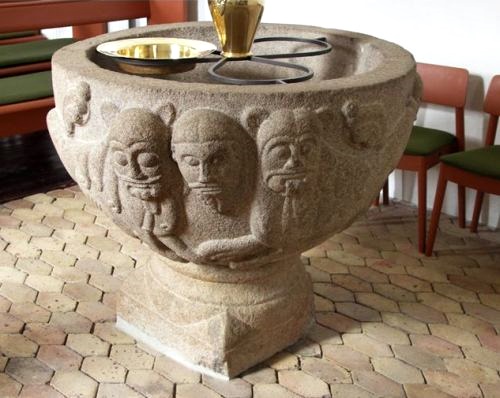
Romanesque font with confronting lions around a man's head in Stenild Church north-west of Hobro. Photo: Søren Kaspersen Minolta.
Svend then retreated to Skaane with the few warriors he had left. After some time he had acquired enough money to ransom his men, whom the Holsteiners had caught.
At the head of his now intact army, he again went against Jutland, perhaps in 1150. However, on Fyn, he learned that his advisor Ebbe Skjalmssøn had died, and that made him so disspirited and depressed that he lost all desire for war, and therefore he brought the army back to Sjælland. Ebbe had been his trusted friend and advisor. Saxo says: "For there had been such a great friendship between him and Ebbe that he did nothing on ting or in the field without consulting him, and both in his own affairs and in the affairs of the kingdom, he followed very much his opinion."
After the battle of Fodevig in 1134, when Magnus the Strong fell together with five bishops, Erik Emune appointed Eskil as bishop of Roskilde.
However, - along with the great chieftain Peter Bodilsen - Eskil very soon launched a rebellion on Sjælland against Erik Emune, the rebels demanded "freedom". The rebellion was turned down and - strangely - Eskil was allowed to live on and retain his position as Roskilde Bishop and Erik satisfied with a monster fine - probably because of his uncle, Archbishop Asser, who financed Erik's victory at Fodevig. However, Erik Emune never gained much confidence in Eskil.

Archbishop Eskil at the head of the Skaane leding. Drawing Louis Moe.
Throughout his reign, Erik Lam loyally respected all of Erik Emune's decisions, but with Eskil, he made an exception and appointed him Archbishop of Lund.
Eskil corresponded with Pope Alexander the third and Bernard of Clairvaux. It was Bernhard, who called on the European kings to convert the pagan Slaws of that days' northern Germany, and it is very obvious to believe that it was his friend Eskil, who mediated reconciliation between Svend and Knud and made them go on crusade against the Slaws.
In 1152, a papal envoy set up the Norwegian Archbishop's seat in Nidaros, thus limiting the Archbishop of Lund's influence to Sweden and Denmark. Eskil now feared that a Swedish Archbishop's seat would be set up similarly and decided to go to the pope in Rome to speak his case.
After many months of traveling on horseback, Eskil met the Pope, whom he knew personally from the time before he became pope. They agreed that Sweden could have its own archbishop's seat, but that it should be subordinate to the archbishop of Lund.
On the way home, he was assaulted, looted and taken prisoner in Burgundy. It was very common in Europe during these times, but the interesting thing is that the pope took care of the matter immediately. Both he and Eskil were convinced that it was the Emperor, who was behind. Eskil's imprisonment became the cause of a protracted dispute between the Emperor and the Pope. It is not entirely clear when he escaped or was released. Some say that only came back to Denmark in 1158 after the battle of Grathe Heath, while Saxo mentions that Svend called Eskil and the Scanian leding in 1155.
Eskil retired as archbishop in 1177. He then traveled to the renowned Cistercian monastery in Clairvaux, where he became a monk. He died in 1181 and was buried near the altar of the Clairvaux Abbey.
Viborg was the capital of Jutland and thus Knud's capital, where the Danish kings had been hailed for centuries. In 1151 Svend moved up through Jutland, and strangely enough, he managed to get the citizens of Viborg over to his side. Saxo says: "he caused the citizens of Viborg to take up arms for him by promising them freedom from all royal taxes."
Knud advanced towards Viborg with a large army, which he had gathered in the rest of Jutland, and they met somewhere near Viborg. As Knud's people later fled into the city, we must think that it was quite close to Viborg, probably within the area of the modern city.
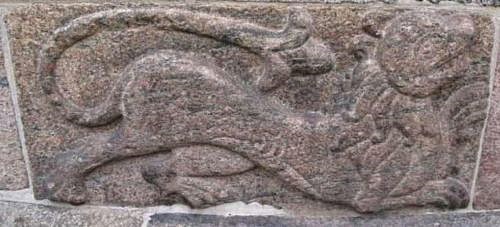
Stone lion relief in the wall of Viborg Cathedral. Photo Viborg Folkeblad.
The old warrior, Saxo, is very interested in military tactics. He believes that Knud had the largest army, and would have won if he had used the cavalry properly: "He would undoubtedly have had the victory had he not followed the advice of his friends and let his riders get off the horses to fight on foot. His chieftains had the opinion, in view of the fact that in the earlier battles they had always been unlucky with the riders, that they should be deprived of the opportunity to flee and by taking the horses from them force them to fight."
Svend had done little else in his adult life than wage war, and he could immediately see that now he had the opportunity to prevail: "Svend had never harbored greater distrust of his luck, but when he saw that his enemies of their own will departed from what should be useful for them in battle, his discouragement turned to the most cheerful hope. He knew full well that when they no cavalry had, they would only come around slowly."
This time Knud was allowed to join the battle: " Knud got with a few horsemen his place among the footmen, that he could see how well his soldiers did their fighting"

Ax head found on the battlefield at Grathe Hede. Photo Museerne.dk.
The Viborg citizens were enrolled in Sven's army, some threw stones: "He ordered the citizens of Viborg, who did not understand how to use horses, to fight on foot, and distributed some of them among the archers and the sling-hurlers; these had small throwing machines and stones as weapons. Next to them, he set up on both sides the riders, who should fall the enemy in the back."
"Knud, who, by the preparations, discerned what the enemy's intention with this double formation was, sought to prevent him from carrying out his intention; so that he should not have the opportunity to fall upon him in the back he led the whole force against his foot soldiers where they stood most dense, and nearly chopped down them all, for there was only made some resistance here and there."
Saxo continues: "But this valiant attack did not ward off the danger that threatened him, for Svend divided his horseback warriors and surrounded the enemy with them from both sides" - "When Knud saw it, he changed the position of his warriors and turned them around and against the horsemen instead of against the footmen, for he considered it necessary that they took up the fight with those, who fell upon them in the back" - "Instead of having a proper battle with them and allowing them to fight back, he harassed them unrelentingly by falling upon them now here, now there, to make them succumb to fatigue and heat, and severely attacked those, who boldly ventured too far from the battle formation, thereby exposing themselves to danger." Provoked by all these attacks from various sides and exhausted by regularly having to defend themselves against all these flank attacks, they eventually became so dull and fatigued that, against all the rules of war, they sat down to rest in the midst of the heat of battle."
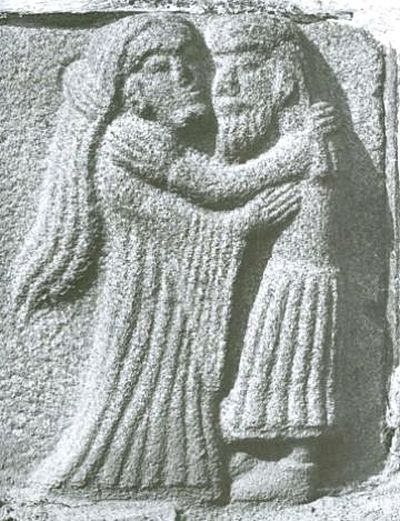
Man and woman embracing each other in the wall of Ulsnæs church north of Slesvig. They may be the founding couple of the church. Photo Grænseforeningen.dk.
"And as they no longer had the power to fight, they found it advisable, as they eagerly looked for salvation, little by little in the closed formations, to move towards the city, whose citizens they had recently beaten on the run, to seek refuge in the houses of their enemies." - "Some of Knud's people immediately fled, some hid in the city, and others ran through the streets and out of it to the other side. Knud himself fled on horseback through the narrowest alleys. Those who had sought refuge in the city were apprehended and taken as prisoners into one of the churches."
It was on this occasion that Svend let all prisoners except two redeem themselves or simply let them go free provided that they swore to be faithful to him.
Svend surrounded Viborg with a defense rampart, Saxo says: "In order to have a safe base in Viborg, which was not fortified at that time, he surrounded it with a rampart and paid the city plenty of money".
After his defeat, Knud traveled to Sweden, where his mother had remarried. Saxo says: "Knud went from Aalborg to Lodose and stayed for a long time in exile with his stepfather Sverker, who after Magnus' death had married Knud's mother." But before long King Sverker got tired of the guests, and Knud had to sell out his properties in Sweden to provide for his people. King Sverker's son, Hans, wrote poems about Knud's defeats and escape: "Sverkers son Hans, who was an extremely brave, but not very courtly man, made also some lampoons about the battles Knud had had and his escapes and provoked him, shameless, as he was, by singing this lampoon".

Approximate course of Viborg's fortification in the early Middle Ages inspired by Sven Kaae and Hans Krongaard Kristensen. Photo Google Maps.
"This humiliation offended Knud so much that he bought ship and food and fled to Poland in confidence that his mother's brothers there would help him," Saxo continues. However, his maternal brothers had recently displaced their eldest brother to eliminate his claim to the kingdom. They believed that Knud came to claim a share of the kingdom as well, and so they looked at him suspiciously and forbade him access to the cities.
Then Knud went to Saxony: "He then went to Duke Henrik of Saxony." But here too he found no support.
But Archbishop Hartvig of Hamburg-Bremen looked more understanding on the fugitive. He had long been annoyed that the Danes had been excluded from the supremacy of his archbishop-seat. Saxo says: "He kindly welcomed him and also assisted him, and he sent secret envoys to Denmark to affirm whether his old warriors were still faithful to him, and they returned with the message that they would all immediately go over to him and fail the oath they had sworn Svend to keep the one they had sworn to him."
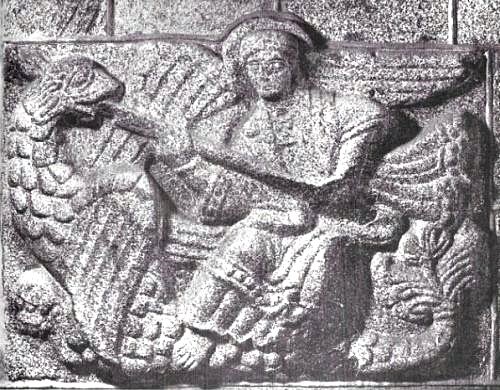
Sct. Mikael and the dragon in Starup Church at Kolding. Photo Lennart Larsen.
Then Knud went up in Jutland at the head of a German army: "Confident in this promise, he went into Jutland with an army of foreign warriors, and neither the goodness Svend showed his people, nor the consideration of the hostages or fear of swearing false prevented his old warriors from placing themselves under his banner."
While Knud traveled abroad to gain support to continue the civil war, Svend fought against the Slaws. Saxo tries to talk him down: "It was now in every way bad in Denmark, for within the borders of the Kingdom the civil war raged, and outside the pirates made all possible mischiefs. To subjugate them, Svend repeatedly waged war in the whole of Venden, but without any real luck."
When Svend learned that Knud had returned, he decided to entrench himself in Viborg. Saxo says: "And he went to Viborg, which he had recently fortified, and decided to endure a siege there. To pay the costs, he ravaged the property of those who had gone over to Knud and used the prey he made to pay his warriors."
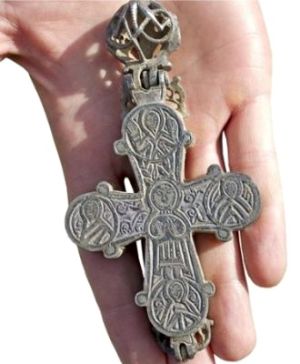
The silver crucifix from Bornholm was found as part of a silver treasure, which has been in a box, and the treasure included, among other things, a curled silver cross and coins made under the German Roman emperor Barbarossa and Svend Grathe.
However, taught by his bad experiences from the last time he was there, Knud made camp with his army at some distance from Viborg without directly to besiege the city. Apparently it was a kind of economic warfare - which Reagan would later use against the Soviet Union - with Knud speculating that Svend did not have enough money in the long run to pay for the army needed for the defense of the city: "He therefore made camp far from it to wait for his rival, when it dragged on, should be starved and then either shamefully take flight or thoughtlessly engage in battle." Apparently, Knud had access to more abundant financial resources than Svend.
Before long could Svend indeed see the bottom in its coffers, and he realized that he had to take the initiative: "Now that Svend had exhausted all his resources, since much was needed to support the warriors in the city, and saw no way out to drag on the war, he thought he had to venture something, though it was connected with danger, and at night, they secretly went the long way to the enemy's camp and came upon them in the morning, when people who were completely unprepared were at at mass."

Valdemar is fighting the Saxon riders on a ford across the river. Drawing Louis Moe.
Valdemar then fought on Svend's side. He excelled at finding a ford across a small stream full of treacherous holes, fight his way across the river and pave the way for victory by establishing a bridgehead on the other side. Saxo writes: "and to that those, who followed, should not have too narrow spaces, he rode a good distance away from the stream, and there he took a position and struggled with his little band so that he kept the whole enemy army up till all his fellow warriors had come over the stream, and it was really him who secured Svend the victory. He goes on to describe the final phase of the battle: "When he came to his rescue, Knud's people fled. For they were anxious and frightened by the previous defeats they had suffered; they could not forget them and they were still desperate and discouraged. To that extent, the adversity they suffered had taken their courage that almost all their bravery had been blown away so that they could not withstand the enemy, but, dulled, as they were by the overwhelming apprehension by which they were captivated they were still easy to chase on the run."
"The Germans on the other hand, who was more accustomed to war and knew how to control their horses, provoked regularly the victors by turning around, simulate attacks on them and thereafter sedately pulling back to their flight in good order. The bravest of them Folrad, fell in that battle" However, most Germans and many of Knud's men were killed: "The others, who had fled in the light of day, came badly from there, for they stayed overnight in a city where they were seized by their pursuers and killed in the houses. The victors had agreed that they would not spare any of the vanquished, partly because they hated the Germans, and partly because they that in the battle before had been allowed to redeem themselves, and had again taken up hostilities against them."
Knud fled to Saxony.
In those days, a man in Roskilde named Vetheman initiative to create a fleet of privateers to fight pirates. Saxo says: "In the same days, as a result of the constant attacks by the pirates, at the instigation of Vetheman in Roskilde, a privateer guild was created, which had the following laws and statutes:"
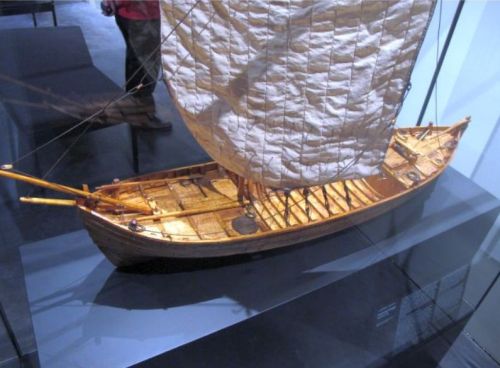
Model of the Kollerup kogge from 1150, found at Kollerup on the west coast of Jutland in 1978. Photo Europäisches Hansemuseum.
They were allowed to seize the ships of merchants and other private persons: "Ships they found fit for war, they were allowed to take, even though their owners did not accept, provided that they gave as freight payment one-eighth of the prey they made to them."
"Before embarking on any mission, they confessed their sins to the priests, and after being chastised by the word of God, they enjoyed the holy supper as if they were about to die immediately."
"They brought only a little travel food, avoided all that might be a burden and hindrance, satisfied themselves with simple armor and meager food, and brought nothing with them that could slow down their sailing."
"When they put into one or another island, they sought always to the side where the wind carried on, but sent scouts over to the side where the wind carried off because foreign ships used to search for ports where the water is still."
"They shared the prey equally among themselves, the mate not getting more than the simple rower."
"When they found Christian people as prisoners aboard a ship they had taken, they gave them clothes and sent them to their home, so much human love they showed their fellow human beings."
"They took at different times and in different places twenty-eight pirate ships, but their fleet never numbered more than twenty-two ships."
"When they were short of money, they let citizens pay to them, and these got in return half the booty. This privateer guild, as I said, in Roskilde, but spread out from the town among the peasants and was supported by almost all of Sjælland, for from a small and low beginning it soon grew large, and its zeal did not weaken in any way until it had again had created peace in the country."
Svend was also not passive in the fight against the Slaws: "In several places on the coast, which by nature were well fortified, he erected ramparts to protect the peasants." He built fortresses on both sides of the Great Belt, possibly at Nyborg and Korsør.
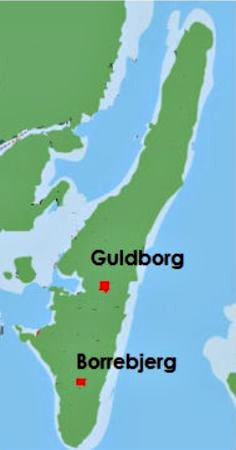
The Langeland Museum has excavated at Guldborg Castle and Borrebjerg Refuge Fortress. In Guldborg they found evidence of a dramatic slaughter of at least 25 men, women and children. It could be shown that most of those killed were left where they fell for a very long time, perhaps more than a year. By a later clean-up, the bones had unceremoniously been shoveled together. Along with the remains of the fallen possessions and other debris, the scattered bones had been used as fill in a slightly submerged access road through the burnt-out gate and at the burned-down palisades. Similar findings were made at Borrebjerg. The youngest coin found is minted under Erik Emune. The Guldborg massacre may, therefore, have taken place at the earliest in the 1130s, but should probably be set to 1140 - 1150.
The findings are generally interpreted as follows: Langeland's Christian Danish residents have sought together in the refuge castle at Guldborg attacked by a large crowd of Slawic pirates. The pirates slaughtered the defenders. As Langeland is completely deserted, the bodies are allowed to lie for many months, perhaps a year, before people came back to the site, where they used the scattered bones to fill in some holes with other waste.
This is clearly a very unsatisfactory explanation. Medieval Danes were deeply Christian, and it was inconceivable that they would not bury their slain countrymen in consecrated soil. Another explanation is better suited to the findings: After several years of pirate attacks, Langeland was more or less deserted. Some Slawic families settle in a new home on the green and fertile, but nearly deserted island. Some Christian Danish men decided it was too much; first, the Slaws come as pirates and killed and expelled the Christian Danish inhabitants, and then they came as pagan Slawic settlers and took possession of the land. They decided to make an endlösung, surrounded the Gulborg Castle and the Borrebjerg Fortress and mercilessly chopped down all Slaws without exceptions. They did not worry about looting. The corpses were allowed to lie where they fell.
Fyn has always been a fertile and rich island, and it has undoubtedly attracted the Slawic pirates as a magnet. Svend and his men made great efforts to defend Fyn. Saxo says: "He fought with them on Fyn, where the Danes fought with great bravery and felled so many of them that most of his warriors had their skin worn out in the hands, so the fingers sat in the bloody meat, such the sword handles had gnawed them." We shall later see that Svend received the support and loyalty of the Fyn people for his efforts.
On the islands, Lolland and Falster are many village names of Slawic origin, which testify that the original Danish population was displaced, annihilated and replaced by Slawic settlers. But on Funen is not a single village name of Slawic origin, although Saxo writes "On Fyn there were also only a few inhabitants left", which shows that the Slaws failed to create lasting settlements on this island and nearby islands. The Fyn people can certainly thank Svend for that.
But Knud had not given up. Saxo says: "However, Knud, with the few people, who had followed him in exile, had gone to Little Frisia, which also belongs to Denmark."
Just as Svend had promised the Viborg citizens tax exemption, if they went over to him, so promised Knud the Ditmarsken people tax cuts if they would support him. Saxo says: "When Knud now asked the people there for help, they were all very willing to give it to him, for he promised them relief in concerning the tax and fees, which they hitherto had to pay, and determined to obtain that the Frisians allowed themselves to be lured to for a little advantage to take on a great burden." - "First they built a fortress on the Milde River so that he could have his home base there."

The difference between clinker-built and carvel-built shell. By clinker building, as on the Viking ships, the shell-boards overlap each other. In the case of carvel construction, the shell-planks are set edge to edge. The advantage of clinker construction is that the planks can be thin and thus the weight of the ship becomes small. Carvel building allows more economical utilization of the wood and besides the ship can be constructed wider midship and thus gain greater load capacity. Tegning Willhig på Engelsk Wikipedia.
When the news that Knud had returned reached Svend, he gathered the Jutland cavalry and the eastern Denmark fleet. Following old custom, Svend let some ships tow over-land from Slesvig to the river Ejder. "From there he went with his army to the newly constructed city," which was well protected by bogs and a river called Mildne.
"Due to the nature of the landscape, King Svend was unable to surround the city, so he camped in a convenient location nearby. He ordered his men to collect branches in thickets and forests, which could be used to lay in swampy areas, thereby creating passing possibilities. However, some of the young Frisians who, whether bored of waiting or eager to put up their bravery, with their familiar agility, leaped across the river separating the camps, and began at distance to attack the enemies, who roamed here and there," tells Saxo. More and more on both sides became involved in the fighting to support their attacked comrades, and it was evolving into a truly decisive battle.
Svends adviser Peder Thorstenson advised him to pull all the warriors back to camp and let them prepare to resist an attack, but so far hold back and not do anything.
Saxo tells: "The Frisians, who did not know this, hurried across the river with all their fighting power, believing that the king inside the camp was not prepared to resist them, and their whole army then attacked with greater boldness than cleverness the enemy eager to take him by surprise." But the Frisians met unexpected resistance and counterattack. Some fled into the swamps followed by riders, who took advantage of the transitions prepared by Svend's men with the collected branches, and many fleeing were killed.
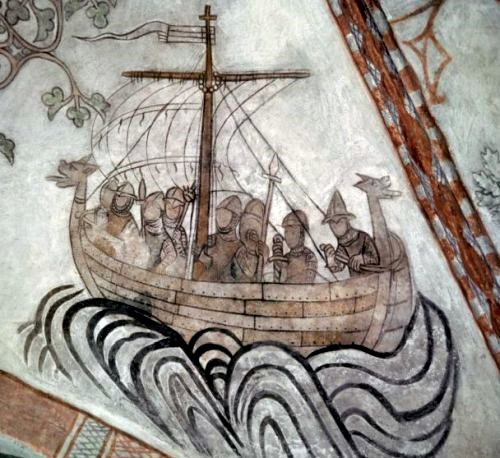
Mural of a leding ship in Skamstrup Church West of Holbæk. At first glance, it looks like a Viking ship - with the same sail arrangement - but it is seen that it is carvel-built, with the planks lying edge to edge. Furthermore, the shell-planks do not extend from bow to stern, as in the Viking ships, here are used much shorter pieces. The ship has no steering oar, apparently, they use an actual rudder. Photo Skamstrup Kirke.
"When the Frisians were chased on the run, Knud fled on horseback with a few companions"
Others sought refuge in a newly built city on the Milne River. Saxo says: "The others, who could not escape, sought refuge in the city. Svend, who believed that Knud was also there, now attacked the besieged with all his might, hoping that the whole war would be over when he got Knud into his power. He replaced the wounded with men able to use arms, those who were dull and tired, with people who had rested; and he did not content to let them fight during the day, but included the night in the fighting, and made sure by constantly pressing on that the besieged did not have moments to rest their weary limbs." One of the reasons why Svend pressed so on was that he feared that other Friesians would come the besieged to help.
Valdemar fought with Svend. He mistakenly attacked some of Svend's people in the dark, believing that they were other Frisians who came to the rescue: "Valdemar, who thought it was the Frisians who came, hurried with the banners to there, where the noise came from, and, after strong resistance, defeated a part of the people of Svend, whom he mistook in the dark for enemies, and thus came the brave duke, fooled by the night, to cause men's death and defeat among them, his intented to help."
Eventually, the people of the city surrendered and became the prisoners of Svend, but he released them all, including his father's murderer, Black Plov. Saxo writes: "The townspeople, who were completely exhausted by the many wounds and fatigue, since they could never have time to rest and care for their wounds, and who received no relief, now gave up hope and surrendered to the king. He proved far more wordy and gentle towards them than they thought he would be, and even Plov, who had killed his father, Erik, he showed a strange grace, for he did not punish his father's killer."
However, Knud had already fled to Germany and the Emperor.
"However, Knud went to Germany and asked Frederik, who had recently become Roman Emperor, for help, promising that he would take Denmark as a fief under him," Saxo tells, "The Emperor, who, by nature, was an exceedingly cunning man, and, to the greatest degree desirous of extending his rule, was eager to submit under him such a great foreign kingdom, and invited under the guise of friendship Svend to a conversation."
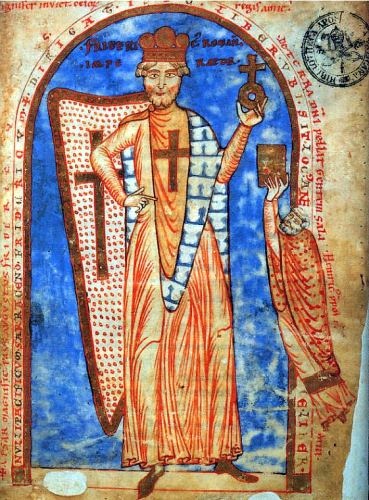
Frederick Barbarossa. He was called Barbarossa by the northern Italian cities which he ruled. Barbarossa means "red beard" in Italian. In Germany, he became known as Kaiser Rotbart, which has the same meaning.
He was emperor from January 1155 until his death in 1190 in Asia Minor while leading his army in the Third Crusade. Photo Wikiwand.
In his youth, Svend had served in Emperor Konrad's lifeguard together with Frederik, who later became Emperor by the name of Barbarossa. Saxo says: Under the guise of friendship, he invited Svend to a conversation, reminding him that they were old friends and comrades in arms." Svend was invited to negotiations in the city of Merseburg.
Svend accepted the invitation. He had become internationally famous because of his many victories in the Civil War. It is said that he: "attracted the attention of all Germany because of admiration for his bravery" - "He was first received by the Emperor with great honor, but it did not take long before various accusations were made against him, so Frederik kept only badly what he had promised."
The emperor's plan was to use the civil war to subjugate Denmark. Saxo says: "Eventually, he was given the condition that he should submit to the Emperor as his vassal, and Knud then again should have Sjælland as a fief under him against renouncing his claim to royal power and authority. If Svend did not accept, the Emperor would support Knud and send a fully equipped army into Denmark with him."
Saxo continues: "Svend, who realized that in such difficult circumstances, he had to either expose himself to danger or give in, he pretended to act on it, but did not completely cut himself off from the opportunity to break the agreement when he returned home by making reservations about the many estates he had inherited from his father on Sjælland."

Silkeborg Museum's excavation of the Svend Grathes chapel. At the site where King Svend Grathe fell on Grathe Heath, a chapel was erected immediately after the battle, which was in use throughout the Catholic era. However, it was demolished during the Protestant Reformation. Silkeborg Museum succeeded in locating the site and excavating the remains of the chapel. Photo Silkeborg Museum.
However, Knud, for good reason, did not trust Svend's promise and demanded that Valdemar should guarantee the settlement. Valdemar hesitated, knowing that the whole deal was pretended and would not be complied with. Saxo says: "However, when the King insisted, he eventually accepted, though very reluctant, making this guarantee, declaring that if Svend broke the agreement, he would go over to Knud."
Saxo continues: "When Svend, accompanied by Knud, had returned to Denmark, he at once sent a letter to the Emperor, in which he plainly accused him of having betrayed him, denied him all obedience, and declared that he did not intend to keep the agreement that he had concluded with him since he had been forced to accept terms which no Danish king had yet accepted."
Svend and Valdemar now agreed to offer Knud not Sjælland as a fief, but instead a similarly large area "distributed in three parts of the country, some in Jutland, some in Sjælland and some in Skaane, assuming that it would weaken his power that his fief in this way was split." Valdemar guaranteed the settlement and Knud accepted.
Finally, Svend was then recognized as the only king of Denmark and could enjoy his dignity in peace, at least in peace of rivals; But the Slaws still ravaged the Danish islands and coasts.

Granite baptismal font from Vær Church north of Horsens. The beast must in all likelihood imagine a lion with mane, so the standing man who is protected by God must be Daniel. Photo Hideko Bondesen Wikipedia.
But Saxo has a lot to criticize him: he "rejected what was Danish, and imitated what was German. He dressed in German, and so that no one should envy him, he made his household troops do likewise so that the king's house was now full of decorative junkers instead of, as before, of men who presented themselves in the way of peasants." - "Yes even for the meals, he chased away the old simplicity, introduced foreign delights and finer table customs, so that not only in terms of clothing but also in terms of food and drink, he introduced noble fashions."
Svend probably knew that despite all his talents and victories, most chieftains recognized only a son of Erik Emune as king because they could not put up with something better. He sought to diminish the powers of the chiefs by his own appointments: "He took the honorary positions from the noble-born and gave them to entertainers, removed eminent and illustrious men from his court, and surrounded himself in their place with a bunch of women-like wretches." - "that those who came to prosperity should have the king's mercy and not their noble birth to thank for this."

|
Peasants who plow their fields. Cover image on "Middelalderens landbrug og bebyggelse" - "En statistisk-geografisk undersogelse af landbrugs- og bebyggelsesforholdene i NV-Sjælland gennem vikingetid, middelalder og tidlig moderne tid" by Johny Grandjean Gosig Jacobsen.
He changed the procedure on tings so that more cases were settled by duel instead of as before by oath. "Lawsuits, which had hitherto been decided by oath, he decided therefore now to be settled by duel and power contests, so that the judgment which should have been subjected to sensible examination of the case now depended solely on whether one had practiced one's body powers more or less", Saxo says.
Court judgment by oath meant that an accused could be acquitted if a number of honest men, maybe twelve, would swear that he was innocent. We modern people will immediately think: Well, yes - it is simply to call the friends. But Saxo clearly believes that an honest man will investigate a case carefully if he has to swear on something. It was, in fact, a kind of jury court.
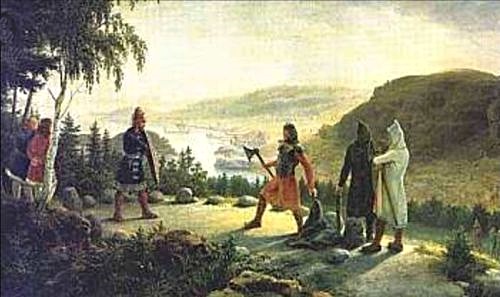
Judicial decision by duel. Egil Skallagrimsson meets the Swedish-born beserk Ljot on the island of Vors, where Egil defends a virgin and fights in her brother's Fridgeir's place. Egil decides the match by biting the opponent's throat. Painting by Johannes Flintø (1787-1870). He was a Danish-born painter who worked in Norway.
A basic idea of a kingdom is that the king and any man of the people are not equal, the king is more than any man of the people. But the king was expected to meet the ting-peasants at eye level. Saxo blames Svend for using a kind of platform when judging at tings: "He held it unworthy for a man in his lofty position holding tings in the usual manner, he scorned to stand on equal footing with the people, when he spoke to it, but used to rise to a higher stage and speak to the people below, when he should decide law and justice."
Svend kept many household troops, and they had many times shown their worth in fighting the Slawic pirates. But they cost a lot of money, says Saxo: "Indeed, the great expense of his many household troops forced him to put more burdens on the peasants both regarding to forced labor and taxes, so while he made sure his household troops could live in abundance, he lost the love of the common people."
Svend's unsuccessful attack on Sweden was in all likelihood contributing to the deterioration of his reputation among the Danish chieftains.
The reason, or the pretext, was that the Swedish prince Hans abducted the governor in Halland, Karl's, wife and sister. It was the same prince Hans, who had made lampoons in front of Knud about his many defeats when he stayed in Sweden during his exile. Saxo says: "When in the same days Karl, the governor of Halland, had traveled out of the country, King Sverker's son, Hans, was kindled by the love of Karls's wife and his widowed sister. Captured by their beauty, he robbed them and abducted them to Sweden to satisfy his desire. He is said to have acted so shamefully against them that he forced them to have intercourse with him every other night, thus violating these chaste women by practicing the most hideous indecency against them, irrespective of the fact that one of them was a married woman and the other an honorable widow.
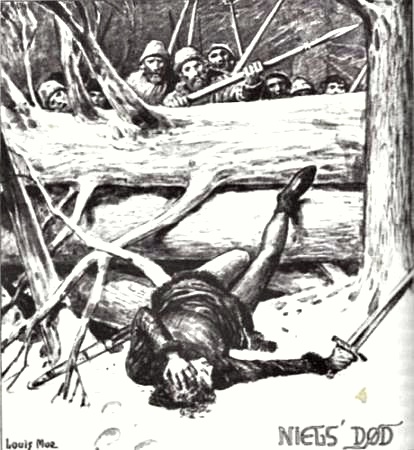
One of Svend's men, named Niels, had just been married before the winter campaign against Sweden. During the campaign, Svend became frustrated because they could not get the Swedes to confront them in battle. One day some peasants had blocked the road with a barricade of tree trunks, Svend jumped up and would attack immediately, but Niels called for soberness. Svend exclaimed: "that married people are always most afraid". They came to the ravine poorly prepared. "Niels, who was eager to wash away the reproach which the king had added to him by supreme acts of manhood, for that it should not be said that his having been married had done away with his bravery, he now stormed the barricade to come over without taking into account the danger, but the peasants, standing on it like on a wall and defending it, pierced his head with a spear." Knytlinge Saga says "In this campaign Nicholas Dotta fell" .Drawing Louis Moe.
"Svend decided to avenge this disgrace upon the entire Swedish people, as a reproach that was added to all Danes, holding that a public humiliation had to be washed jointly," Saxo continues.
However, he did not have time to wage war right away, having first to have a wedding with a daughter of Duke Konrad of Saxony named Adele.
At this time got Svend visit of the Pope's envoy Cardinal Nikolaus, who tried to get Svend from his intention of waging war against Sweden. He argued: "It was difficult to wage war in the country and the people were poor, so there was no advantage in overcoming it. It would be a very costly campaign for him, which would yield little profit; before he could fight the enemy, he had the mighty, wild mountains to fight with, and when he finally got away with the victory, there was only a small and insignificant prey to win"
The culprit, Prince Hans, was soon after killed on a ting by the Swedish ting-peasants and the Swedish king begged for peace. Saxo says: "However, in his fear of war, Sverker repeatedly sent envoys to Svend to ask for peace, but it did not help whatever conditions he offered him."
Svend's great qualification as king was his military prowess; he triumphed almost everywhere he came. Maybe he wanted to improve his position compared to the Danish chieftains with another brilliant victory, or maybe he wanted to increase his royal income.
He postponed the campaign once again as he wished to wage war in the winter to avoid: "troublesome meandering detours" and "take shortcuts across the ice-covered swamps".
As the winter cold set in: "he went by the nearest road into Finveden, where he ravaged and burned everywhere. The people of the land came continually, asking for mercy, and surrendering themselves and the land to him, and they did not only allow themselves thus to submit, but even provided him with food, and showed him all willingness and hospitality." - "Then went he entered Värend, where he everywhere pushed forward with fire and sword, for the people of the land neither fought back nor surrendered, but both men and women sought on every side into inaccessible deserts." The cold was very severe. Saxo says: "Almost everywhere in the fields lay high snowdrifts, and the cold was so severe that infants froze to death at their mothers' breast, while the mothers were close to suffering the same fate, squeezing themselves half-dead the dead children to their bosom."

The Swedish peasants fleeing for Svend's army. Drawing Louis Moe.
The Danes could not endure the cold, they: "also suffered from this harsh weather, could not camp at night and not keep watch; some of them made bonfires, others sought under roof, more afraid of the cold air than of swords and spears, and thought more of guarding themselves against the cold than the enemies."
The Danes met only scattered and half-hearted resistance, but the men suffered from the cold, and many horses also died due to the cold, the difficult roads and the lack of fodder. Many of his men slipped away and went home: "Those, who had lost their horses and had to go on foot, now put what they had to carry on the horses of their comrades, drove them in front of them and left without the king's knowledge on the way home."
Eventually, Svend decided to give up the campaign: "When it finally dawned on him that the army was disappearing, he got in afvance of its secret retreat by allowing the warriors to return home and immediately set out on a shortcut to Skaane."
The following summer, Svend had serious political problems in Skåne, it is not known why, but one can imagine it was because of extraordinary taxes and fees to pay for the failed campaign. Saxo explains: "Some time afterwards, the common peasants in Skaane rose against the chieftains and rallied to armed ting in Arnedal. Whenever the people of this region found the burdens imposed on them too heavy, they always oppose with force to counteract the injustice they felt was added to them; when the common people who think its yoke becomes too heavy, it always tends to resort to weapons to protect their freedom."

|
Unfolded motif on the baptismal font in Vester Tørslev Church south-east of Hobro. Double body lions, a woman and a phallic man around and under the baptismal font. Motif from "Romanske Stenarbejder" from the publisher Hikuin.
Svend showed up unarmed on the thing and had only a few armed riders with him for his personal safety. The peasants allowed him to get into the thing, but then "they overwhelmed him with a multitude of grievous complaints, and cried and screamed so that he could not get the possibility to say anything and defend himself. When he reached out with his hand to command the mob to be quiet, a great number of stones were thrown at him, to that extent the rebels' rage was flamed up to scorn and contempt for his royal dignity. A man named Toke Signesson managed to calm the crowd.
Svend let the chiefs behind the unrest execute. Saxo says: "When peasants again had gone their separate ways, the king in his outrage over the shameful indignity that had been given him, let several villages burned down and ravaged almost the entire Scania as punishment because it had been guilty of offending a royal majesty." He also punished Toke Signesson, saying that he himself had helped to cause the unrest.
Due to Svend's political weakening, new hope sprang up in Knud's camp. Saxo says: "Knud's advisors also felt that he should see Valdemar divorced from Svend before embarking on a war with him and that he should seek to win Valdemar's friendship by marrying him with his sister. To achieve this, each time they spoke with Valdemar, they deliberately praised Knud's half-sister, Sofia, for her great unusual beauty."
Sofie and Valdemar later had eight children together, so we have to think that it was a kind of love. But in first case, Valdemar understated his interest. Saxo says: "Valdemar said that the virgin's poverty was an obstacle for him to marry her, for her father was a Russian, so there was no estate at all to inherit in Denmark"

|
Baptismal font in Sall Church between Aarhus and Viborg. The motif is male heads surrounded by predators, presumably to represent lions. It should probably illustrate Daniel in the lion's den. He is surrounded by hungry predators, but God protects him. Photo Pinterest.
But when Knud promised to give her a third of his inheritance from his father, Valdemar allowed himself to be persuaded and he engaged with her and "entrusted a married woman by the name of Bodil to take care of her upbringing until she became old enough to be with a man."
It must have been fantastic news in Denmark. The fatal war was initially triggered by Knud's father, Magnus the Strong, killing Valdemar's father, Knud Lavard. With varying intensity, the war had raged for about 25 years and cost thousands of lives. A romantic connection between the two parties in the civil war should really give hope for reconciliation and peace.
Saxo does much to describe Svend's suspicion and hatred because of the reconciliation between the two genera. As Saxo writes: "Because he realized that most of his power had gone away from him with Valdemar, on whose fortune he had not hesitated to support his own". This is not entirely true, as it was Svend's father Erik Emune who swung himself up to be king by taking on the slain Knud Lavard's and the unborn Valdemar's case, a case that his son Svend had inherited. Svend must have felt the blanket was pulled away under him.
Svend's suspicion was not unfounded. As we see below, it was Valdemar and Knud, who revived the civil war by letting themselves be hailed as kings at Viborg Ting, which was a clear declaration of war against the established king, namely Svend.
Knud and Valdemar escalated the situation. Valdemar "sailed with Knud over to Sjælland with the entire Jutland navy, not because he intended to inflict war on the king, but to better secure himself against faithlessness from him for the future. Svend met them with a group of armed men at Sundby, a village by the sea, and here they negotiated all day. Eventually, they agreed, and at bedtime, the king returned to Roskilde." What they negotiated is unknown.
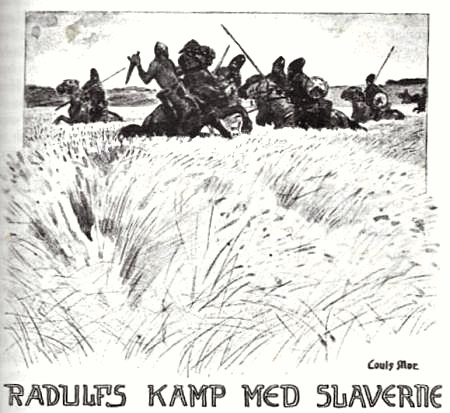
Radulf in battle against the Slawic horsemen.
But it was still Svend who defended Denmark. He was the king that the enemies feared. Precisely on this day, Sjælland was attacked by an unusually large Wendic fleet. Saxo says: "Since they had already devastated all the fields, they passed all the places where no prey was left, and intended to take Roskilde by surprise." - "Now they had also heard from their scouts that everything was quiet in the city and that the King was far away."
"The first of the Danes to engage the enemy because he had a very fast horse was a very capable rider named Radulf." He rode through the cornfields to warn Roskilde closely followed by Slawic riders. He soon got company by Svend's household troops: "However, the royal horsemen, depending on their speed and courage, came out to Radulf and joined together with him into a unified group." - "As soon as Radulf, judged on the cloud of dust that rose, realized that the King was near, he attacked them in confidence of the support that was underway. The Slawic footmen were cut down and fled, but their riders, who had joined into a unified group, first pretended flight, but when the King threatened them in the back, and they saw how few horsemen he had, they turned and chased him on the run. Radulf now stopped the carnage on the footmen and attacked the Slawic horsemen with his men and forced them to flee seriously over in panic" - he "joined the King's group of riders again took up the carnage on the footmen."
It became a complete massacre on the Slaws: "A few of them reached the shore and swam out to their ships, some who, too hastily, sought salvation in flight, ran blind from horror into the water and drowned en masse" - "The Slaws, who fled in panic and were so eager to get into the safety from the enemies' sword that they in womenlike fear set out over a cliff with their horses and perished, so they, with mutilated bodies, had to give up their lives between the stones."
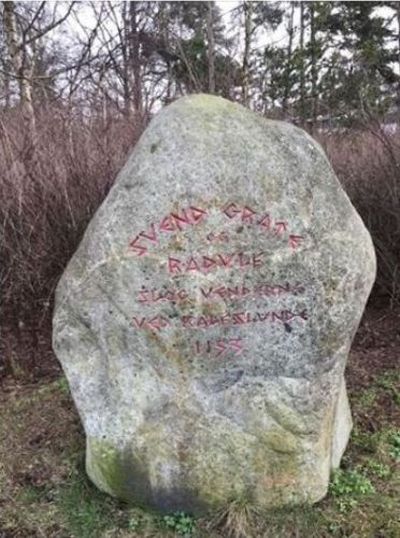
Memorial stone for Svend Grathe in Karlslunde between Copenhagen and Køge. The text reads: "Svend Grathe and Radulf beat the Slaws at Karlslunde 1155". Photo Morten Dahlin in Facebook.
Knytlinge Saga confirms that Svend defeated the Slaws in a big battle: "In the morning after, King Svend fought with the Slaws at Kalvlunde, and had victory and killed many people."
Saxo does not restrain himself in his description of the ravages of the Slaws: "All the villages in the eastern part of Jutland are deserted, from Vendsyssel all the way down to the Ejder, and the fields lay uncultivated. The eastern and southern parts of Sjælland were also deserted, for there were no peasants, and the pirates remained there as if they were at home. On Fyn, only a few inhabitants were left. The Falster people, whose bravery is greater than their land, their courage compensated for that their county is so small, for they do not want to pay the enemy taxes, but kept him away with good means or by force. Lolland, though larger than Falster, on the other hand, made peace by paying for it. The rest of the islands were deserted. It has been said that he described the situation so badly to make his hero, Valdemar's achievement even greater, when he later as sole king finally solved the Slawic problem.
Svend traveled to Germany to visit his father-in-law Konrad, "under the pretext that he would demand the dowry of his wife." - "and among those he chose to accompany was Valdemar, partly because he did not feel safe leaving him at home, and partly because he wanted Konrad to keep him in jail." Saxo describes that Valdemar had received letters from several friends warning him against precisely this. He blamed Svend for his unfaithfulness, but Svend refused to have such plans. Then Valdemar showed him the letters, however, so that the signatures were cut away. After various entanglements, the company returned home to Denmark, and no further action was taken.
It cannot be ruled out that Valdemar himself had these letters produced to have a pretext for failing Svend in favor of Knud, which he soon after did.
Somewhat later, Svend went to Fyn with an army, which Saxo believes meant that he was secretly on his way to Viborg to surprise Knud and Valdemar. Then: "- however, they caused the Jutlanders to proclaim them kings". Which was a challenge against an established king, namely Svend, and a clear statement that they intended to resume the civil war.

Odense Castle was located on a peninsula, which extended into the Great Næsbyhoved Lake, which today is dried up except for the part of it which has been dug deeper to Odense Harbor and Canal. The castle was completely destroyed by the citizens of Odense during the Count's feud and the stones were recycled, probably to buildings in Odense City. The site still has a 10-meter-deep moat. Today there is access to the castle hill behind Restaurant Næsbyhoved Skov. Here you can see the castle bank through the trees on a winter day. Photo Odense Bys Museer.
Saxo writes: "The king now gathered his warriors in the castle of Odense, where he was staying at that time, and started to ask them, partly individually, and partly as a group, what fidelity he might expect from them in the war that was now at hand. Although they eagerly replied that he could trust them, he would not be satisfied with a simple and accurate promise, but demanded that they should confirm it with an oath."
It was also Knud and Valdemar who initiated the hostilities. Saxo writes: "When Svend, after his people had sworn allegiance to him, had returned to Sjælland, he was soon attacked by his rivals with the Jutland fleet."
Svend also invited Eskil and the Skaane leding army to join him in Roskilde and decided to await the enemy attack in this city.
However, similar to his second battle at Viborg, he had trouble supplying the large army which he had assembled in Roskilde. Saxo says: "When food became scarce, he sold several of the royal estates to provide food for his people."

Reconstruction of Roskilde's fortification under Svend Grathe as much as possible according to Roskilde Museum's description: "The rampart went all the way around the current city center. From the Red Gate, which was where the Hestetorvet crosses into Algade towards what we today call the Red Gate, it went south to the station (Sankt Peder Sogn) along the east side of the Hestetorvet. Just east of the railway station building, it turned west and followed the current Jernbanegade (formerly Smedegade). On this stretch, the rampart formed the southern boundary of Vor Frue and Skt. Nicolai Sogne, and at the end of Hersegade there has been a south gate (later towards Koge). Where Jernbanegade to the northwest runs out into Ringstedgade (here also was a gate), the violence struck an arc to the north and followed the two roads named after it: Borgediget (west boundary of St. Budolfi Sogn) and (after Budolfi Gate at Stodens outlet) Byvolden (west boundary of St. Mortens Sogn). Where Skt. Claravej begins today, turned the rampart to the east and formed the northern boundary of Skt. Hans Sogn. The rampart has run along current Birke Alle and Bellevuesti on the border between Provstevænget and the city park, where it can still be seen in the terrain. Somewhere along this stretch, probably at Tuttesti, there was a smaller gate to the north, so you had access to the harbor. The large gate to the north lay where Skt. Olsgade crosses Frederiksborgvej. From here the rampart went east as the northern boundary of Skt. Olai Sogn traverses the current Folkepark (where there are also traces of it in the terrain), where it swung south up to the Red Gate at Hestetorvet through today's Sortebrødrestræde." However, the author had to ignore the information about: "The large gate to the north lay where Skt. Olsgade crosses Frederiksborgvej." In that it will give the rampart an illogical course compared to the other information. Foto Google Maps.
Archbishop Eskil received money from the enemy to betray Svend: "When at last, after he had spent the money for many estates it looks like that he would have to let his army go apart, because it cost him too much, found Eskild, who expected a general desertation, a cunning by which he turned the menacing danger to his advantage. First, he secretly demanded a large sum of money from the enemies as a reward for his desertation from Svend, and soon afterwards he went with the Skaane people to the King, complaining that food was so scarce, asking him to send them away which he could not feed." - "Having said this, he left, as if thereby giving a valid reason for his desertation, from the royal castle with the Skaane warriors."
It was probably so that Svend could not take the offensive, as he did in Viborg, because the enemy was numerically superior to him, which is why he entrenched himself in Roskilde. Besides, Knud and Valdemar must have had extremely superior financial resources, since they could afford to wait with such a large army, thus exhausting Svend financially. Knytlinge Saga says: "They made camp in Lyngby in Valby Herred".
Therefore, one must think that Svend - despite his good will, all his talents and many victories - was not supported by the majority of the Danish chieftains. Nothing personal - but they just did not want a son of Erik Emune as king.
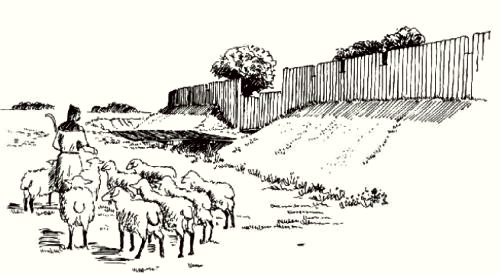
Graphic reconstruction of Roskilde fortification. Roskilde History gives more details: "The rampart does not seem very big with a width at the foot of about 10 m, but on the other hand its extension is very large. There can be a city of one kilometer on each direction within the fortification (approx. 73 ha), and so large was no other Danish city in the Middle Ages except Lund. The same applies to the east and the National Park. Behind the rampart, traces of narrower graves or trenches have been found in some places. to direct the water from within the urban area through the violence at appropriate places - for example, at the gates. The moat in front of the rampart has been slightly wider than 10 m. and it has been partially water-filled. This applies to the west side along the Borgerdiget and especially Byvolden, where spring water has flowed into the moat. The same applies to the east and Folkeparken. Behind the rampart, traces of narrower graves or ditches have been found in some places. They have probably been there to direct surface water away from the area behind the rampart so that the defenders did not get wet feet, but also to direct the water from within the urban area through the rampart at appropriate places - for example. at the gates. " Foto Roskilde Historie.
Saxo writes: "When already the greater part of the army had now run away, the king was plotting to flee and went in great haste on the road against Falster with the rest of the warriors, without even his advisers had any idea what his purpose was to go so far from the city. When his men found that there was an escape, they tried to persuade him to fight: "It would also be the greatest shame and disgrace to flee before they had fought and voluntarily hand over the victory to an enemy, they could overcome." But Svend would not, they could not get him to give up his intention.
Svend's warriors decided to take up the fight against the enemy without him. They waited a long time, but no enemies came. Saxo says: "The Jutlanders believed that Svend's retreat was a war cunning, and therefore out of fear of ambush they preferred to advance slowly."
Finally, Peder Thorstenson suggested that they disband the army and go each to his own: "Eventually, Peder urged them to dissolve the army and try to save themselves home to their own, for it was utterly foolish, he said, to have a battle when we have no chieftain."
Saxo believes that Svend stayed three years with his father-in-law, Count Conrad of Meissen, and then he decided to return to Denmark: "After spending three years in exile with his father-in-law, Svend died, and he then gave hostages to the Duke of Saxony and promised him a large sum of money if he could help him to the kingdom again." Knytlinge Saga says that "he came to his brother-in-law, Count Konrad, wiyh whom he stayed for three months," which is hardly enough to the wandering around abroad that later is told.
"The Duke then agreed to the payment offered, moved up to Danevirke with a large army, escaped by bribing the concierge, and then besieged Schleswig, whom he taxed on fire." Saxo continues. "There, Svend plundered a foreign fleet and seized a wealth of Russian goods, which he gave to his warriors as payment, thereby not only keeping the many foreigners away for the future but also causing the splendid merchant city to descend into a small, insignificant village."

In the Vindeboder area in Roskilde some very characteristic Slawic knife sheaths and pottery remains are found, which originate in Slawic area. Many historians believe that Vindeboder means Slaws' stalls and finding these effects mean that Vindeboder has been a Slawic settlement.
But Saxo describes that precisely in Roskilde, Vetheman's Fribytterlaug emerged, which had victory every time, conquered many Slawic ships and took great spoils. It would be quite obvious if such a maritime privateer guild had their storehouses at the harbor - for example in Vindeboder - and the knife sheaths and the Slawic pottery are remnants of the prey that were distributed.
Furthermore, the term Vind- does not always mean Vend (Danish for Slaw). For example, in Odense there is Vindegade and there are no indications that there have been especially many Slaws living there. The name very likely describes the street is meandering through the city, it "vinds". And Vindeboder in Roskilde may well have meant a Klondyke-like settlement where the streets meander in and out between many small stalls in an unpredictable way.
The Saxons plundered recklessly through Jutland and "and those who had previously promised Svend's help would not assist him as he came with foreign warriors, because they did not want to have the reputation that they have helped a foreign army force against their motherland."
However, the Saxons were informed that a very large army had assembled against them and so they decided to return to Germany very quickly. Saxo writes: "The way they had used half a year to travel, when they came, they now passed in three days."
Svend now sailed to Fyn, who had just been exposed to a very large Wendic attack. The Fyn people had not forgotten his previous efforts against the Slaws on Fyn. He was received as a true king who returns. Saxo writes: "The Fyn people showed such fiery eagerness to protect him and serve him that flocks of men and women streamed to him from everywhere to fight for him, considering it a worthy deed to help the King's urgent cases on their feet again against them, who had taken power in the Kingdom."
Knud and Valdemar gathered "the entire armed forces of the rest of the Kingdom on land and at sea against the Fyn people" But so that it should not "have the appearance of more harming the land and the kingdom than the enemy" they preferred negotiation. It was then decided that "Svend with his household troops should go to Laaland and remain in peace there until a complete peace was reached between him and Knud and Valdemar".
The day after, Valdemar rode to Odense "to bathe". Knud didn't dare to go "for fear of treason." Valdemar was received by Svend "with a solemn procession of monks meeting him with the saint shrines."
Saxo writes: "Svend then led him into St. Albani Church, and none of their counselors other than Absalon were allowed to follow." Absalon was Saxo's superior, and therefore we believe that it is essentially true, what he recounts about the conversation in Odense.

Valdemar and Svend talk together in Albani Church in Odense. Drawing Louis Moe.
Svend initiated the conversation: "An evil fate has so far envied me your friendship, Valdemar," He talked about his father Erik Emune, his father's friend Erik Lam and finally himself protecting Valdemar during his upbringing. "Had he not (Knud) feared me as a third person, he would not have tolerated you as the other in the group of leaders. As long as I live, I will protect your life from his cunning plans; when my last hour comes, so does yours."
Then Svend completely placed his destiny in Valdemar's hand: "In trusting your loving heart, I now make you a peacemaker on my behalf. I will be pleased with the lot you will grant me, for I have gone through so much misfortune in foreign lands that I would rather live as a low ranking and poor man in my native land than be condemned to exile again. I also think that when you consider everything judiciously, you will hold it a disgrace to unite with the son of your father's killer rather than with the son of his revenger."
Valdemar denied - of course - that there should be problems between him and Knud and again made his accusations that Svend wanted him imprisoned in Germany. But he would still take on the job as peacemaker: "But so, as not to be blamed for turning my back to family, I will now try to help your cases on foot again, even though I put my life at risk, but I do not do it because I trust your promise, but because of compassion with your bad fate."
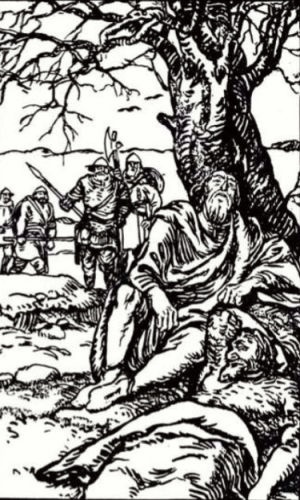
The death of Svend Grathe in the Battle of Grathe Hede. Saxo describes that he was so exhausted that he "sat down on the root of a lone tree that stood there, for his strength failed him so much that he could not drag himself away even when he leaned on others." Photo Docplayer.
Svend assured that he was not scheming to betray him "as he had no need to provide for his own or his children's interests. He himself was so ill, he said, that he could scarcely have another year to live in, and he had no sons that he should try to give the Kingdom."
Then Svend went to Lolland as agreed. Upon the news of his return, many of his old warriors flocked to him.
Saxo tells: "At the appointed time Knud and Valdemar went to Laaland with all the Danish nobility. As Valdemar used to associate with Svend in a more confidential way, he went to him with a few companions, while Knud still distrusted his honesty." Svend invited Valdemar to a new confidential conversation for the two of them only, which Valdemar agreed to: "- and they talked together, and called Noblemen to meet the next day."
Saxo says: On the Noblemen's meeting "Svend with Knud's consent made Valdemar the arbitrator and declared that what he decided he would accept. Valdemar then decided that all three should have name of king, and divided the whole kingdom into three parts, one of which was Jutland, which was both large and had a population corresponding to its size, the other Sjælland and Fyn, and the third Skaane and its connecting provinces. As the one who made the division, he had the right to choose first, and then he chose Jutland and then gave Svend permission to choose. In order not to be squeezed in between his two rivals, Svend chose Skaane, and the islands, which the others had bypassed when they chose, thus came to belong to Knud."
When they had entered into this agreement Knud and Valdemar went to Roskilde. Sjælland was given to Knud, and he would prepare a feast in Roskilde for Svend, who promised to come soon.
Svend was careful. The provost in Ringsted, which was accompanied by the German knight Radulf, told Knud that Svend had got intelligence that Knud would meet him with a large number of armed men, and therefore he also surrounded himself with armed men. Saxo, who is certainly Valdemar's man says that it was because Svend had sly plans. But, no one knows, it could also be Knud - or both.
Saxo says: "He spent the night there with drinking and merriment, and at dawn, he set off with a small following out to Thorbern's farm not far from the town as if he were anxious to see his little daughter, who was being raised there." In the early evening, Knud sent some people to get him back.
The kings sat in the same room. The tables were taken away and people sat and drinking and talking about this and that. Svend praised himself for being a master of the chess game, which had been his main pleasure during his country flight abroad. But there was no table for the game. A German singer entertained with a song about Svend's escape and his wandering abroad, some silenced him, but Svend said that he did not mind that he sang about his suffering as they now were over.
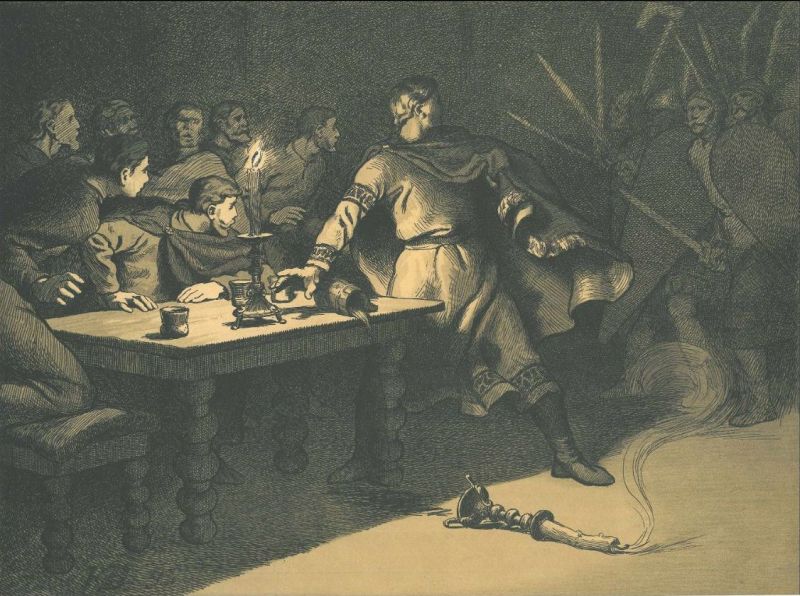
|
The Blood Feast in Roskilde. Illustration from Danmarks Historie i Billeder.
Saxo writes: "When twilight came candlelights were brought in as usual." About the same time, Ditlev, one of Knud's men, entered the room after briefly having been out. With an imperceptible nod, he let Svend understand that he wanted to talk to him. Svend got up and talked to him. Svend's men stuck their heads together.
Knud grabbed Valdemar's arm and gave him a kiss. Here we give the word to Knytlinge Saga: "King Valdemar did not look away from the board, but asked, "Why are you so gentle, brother-in-law?" King Knud replied: "You will soon know."
Shortly after Svend left the hall followed by a waiter with a candle and retired to his chamber. But his warriors remained. Saxo says: "Those, whom he had ordered to do so, attacked immediately Knud and Valdemar with drawn swords. However, Valdemar quickly jumped up from his seat, wrapped his cloak around his hand and not only fended off he blows aimed for his head, but also gave Ditlev, who violently bumped into him, such a blow to his chest that he tumbled to the ground."

Absalon with the dying King Knud. Knytlinge Saga explains that Absalon only came to the scene after the events took place. It was dark and he initially thought that the badly wounded man on the floor was Valdemar. Only after some time, he could see that it was Knud. King Knud then passed away with his head in Absalon's lap. Tegning Louis Moe.
"Valdemar also fell himself and was severely wounded in the thigh, but he immediately got back on his feet, and with no regard for his wound he broke through the crowds standing in his way and ran out the door; somebody, who came against him in a dark place and seized the tassels in his belt to hold him back, he slid away."
"However, somebody opened the windows so that darkness could not prevent them from completing their crime. Ditlev sprang up from the floor and split his head on Knud, who had nothing but his hand to fend with."
Valdemar and two of his men managed to escape into the forests.
Saxo says: "At dawn, Svend called the town's citizens and complained to them that his fellow-kings had betrayed him by night, showed his robe, which he himself had diligently pierced, and said that Knud and Valdemar had violated the rules of hospitality, called them dishonest men, robbers and murderers, thanked God for that he by the death of one of them had prevented the crime, both of them had planned." He ordered all ships on the whole island to be leaked and all desolate places to be carefully searched.
But with the help of Esbern Snare, Valdemar managed to get hold of a ship, and in a storm, he managed to transfer to Jutland.
For eight hundred years, Svend has had the role of the villain and the conspirator, but was it really him? All the evidence rests mainly on Saxo's history, and we must believe that he was biased, being in Absalon's and thus Valdemar's bread. Saxo's account contains many indications which he really could not know, such as "a mob of the King's warriors stood waiting fully equipped and instructed to kill Knud and Valdemar", "Knud realized that there was treason on the move" and so on.
Saxo's report also contains unlikely elements, e.g. "However, Valdemar quickly jumped up from his seat and wrapped his cloak around his hand". You cannot manage to wrap a cloak around your hand in a split second when an attacker rushes against you. Furthermore, the participants in the party had been drinking all day and also the day before, did anyone really notice the very small details that Saxo describes, such as Ditlev going in and out and nodding imperceptibly to Svend? It may well be literary constructions by Saxo.
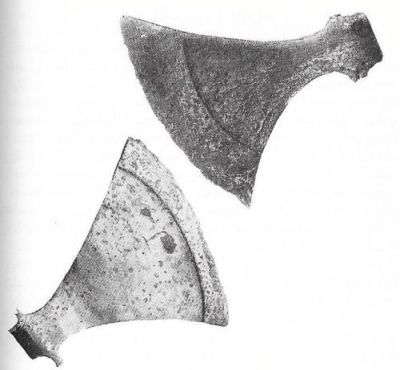
Axes from the Battle of Grathe Hede. The Viking Age's Danish ax was still popular in the 1100's. Foto Myarmory.
Much depends on whether it was true that Svend said he was ill. As he himself says, it explains his willingness to compromise, it may explain why he went to Thorbern's Farm - to rest. It might explain why he went to bed earlier than the others. It is made probable by that he was so utterly exhausted in the battle of Grathe Heath.
Moreover, could Svend reasonably expect to become the sole king if he killed the other two? His big problem, after all, was that he was the son of Erik Emune, and if he killed the other two, he would simply prove that he had inherited his father's cruelty.
But what about Knud? After all, he is generally considered innocent - because he did not survive. Saxo never gets tired of describing that Knud was an anxious person, who saw treachery everywhere. But thieves believe every man steals. He may have arranged an assassination, which however was disclosed to Svend and failed.
Knud had experienced a fall from the peaks. He was the one, who had the most to gain. Previously he had been sole king in Jutland and Fyn, but here he was now completely displaced by Valdemar. He had been appointed king of Sjælland, Fyn and the islands, a region that obeyed Svend's smallest hint, which should be shown immediately after the blood party.
Knud had learned that Svend and Valdemar had had several conversations for two persons only, the first time in St. Albani Church in Odense and sthe econd time on Lolland. A fearful and anxious person, like Knud, might think that something was brewing, and it was better to take action first.
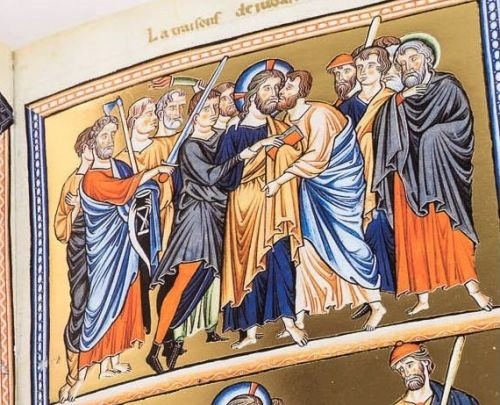
Judas identifies Jesus to the Roman soldiers with a kiss. Ingeborg's Psalter, around 1195-1205 e.Kr.
Knud "embraced Valdemar and kissed him", but according to Saxo, he would not say why. But Knytlinge Saga, which is independent of Absalon and Valdemar says that Valdemar asked:: "Why are you now so gentle now, brother-in-law?" King Knud answered: "You will soon know." It may well have been a Judas-kiss, a signal to Knud's men to seize and kill the other kings, as Judas identified Jesus to the Roman soldiers with a kiss. When Knud answers: "You will soon know" it indicates that he knew what was going to happen because it was his own plan. This theory depends on that it is not true that Saxo writes that Svend withdrew shortly before the event. One can also imagine that the Svend's men had been informed of what would happen and immediately withdrew their king to safety, or that Knud in the darkness had not noticed that Svend had left a few minutes before.
Valdemar was a man who had really made political progress. From being Svend's second in command - perhaps not even that - he had succeeded in becoming king of the largest part of the Kingdom, namely Jutland. One of his rivals was probably ill and did not have a long time left, and the other was an anxious type, who would sooner or later do something unwise. Should we imagine that Valdemar would put all this at risk by arranging an assassination on his fellow kings? Furthermore, Valdemar was an intelligent and calculating man, yes maybe even sly. In many other situations, it is seen that he took action only if he was sure of winning - and that assurance could not be offered by an all or nothing assassination. It is very unlikely that Valdemar was the conspirator, although Svend may have thought he was one of them. Valdemar just cleverly took advantage of the events - as they played out - to his own advantage.
It thinned out very quickly among the witnesses to the episode in Roskilde. King Svend and Yngvar Kveisa fell in the battle of Grathe Hede. Valdemar let Ribe-Ulf and Ditlev execute after the battle. Eventually, only Absalon and Valdemar knew what was really happening, and Absalon said that he did not enter the room until after the events.
Upon his landing in Jutland Valdemar went immediately to Viborg Ting, where he presented Svends atrocity. Saxo says: "He made his way to Viborg, where he complained about Svend's betrayal and aroused sorrow in everyone's mind by the sad tale of what he had experienced. The sight of his wounds garnered as much attendance for him as confidence in his words, so it is not easy to say whether that wound was beneficial to him or harmful."
Svend ordered leding in Skaane and on Sjælland and assembled ships on Fyn and Sjælland. Valdemar wanted to be sure of his supporters in Jutland. Saxo says: "Valdemar, who thought it was uncertain what outcome the fight would have, returned to Viborg, where he celebrated his wedding, partly to make it easier for those who had fought for Knud to go over to him and partly to that the enemies should not be able to rob his beautiful fiancee of her chastity."
Svend went ashore at Djursaa, which we believe is located near Djursland. From here he sent riders to Viborg, whose citizens had previously supported him. Valdemar then sent two men named Saxe and Buris to the enemy fleet at Djursaa. They succeeded in persuading the Sjælland people to fail Svend and sail home. The Fyn people, on the other hand, did not want to let him down. Saxo says: "The Fyn people, on the other hand, for whom the consideration to the king was more important than what some men said, did not heed their admonitions."

|
The Battle of Grathe Heath. Saxo says: "The man who carried Svend's main banner, jumped off the horse and set off on the enemy, encouraging the fleeing warriors to take up the fight again, but when he saw that there was no rescue, he planted the banner in the ground, held on to it with his left hand and felled with his right hand those who came near him. Eventually, after fighting famously, he was felled by the multitude of enemies that gathered around him." Lorenz Frølich Wikipedia.
Thus weakened Svends army went apparently against Viborg. But Valdemar still did not feel confident of victory. He broke the bridges over a river separating the two armies so that Svend could not cross. After quite a long time, Valdemar finally figured that he could win. Saxo says: "Eventually, Valdemar, whose army grew with each passing day, got the courage to deliver battle and decided to cross the river in another location and attack the enemy."
The armies met at Grathe Hede north-west of Hauge Lake between Silkeborg and Viborg. Saxo makes a point of explaining how Valdemar did not allow his people to feed the horses the night before the battle so that their full stomachs would prevent them from running. Svend, on the other hand, allowed his people to feed the horses with the plentiful amounts of grain that just now covered the fields.
Valdemar had overwhelming superiority. Saxo says: "When Valdemar advanced after having organized his army, he saw a crowd emerge from one side with shiny weapons and splendid banners. He at first thought it was enemies, but then he was told by his scouts that those he feared were comrades in arms. He incorporated them into his battle formation and now he went so much more confident against the enemy, for his army had now become so large that not a tenth of his people could see where the banners stood."
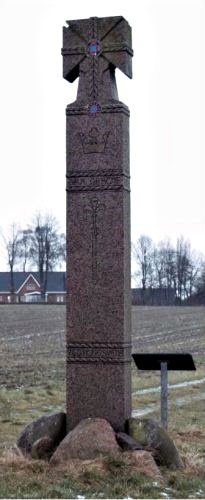
The Grathe stone on Grathe Heath. According to local tradition, Svend Grathe was buried where he fell, and then a chapel was erected on the site, which, however, was demolished in connection with the Reformation. Here have previously been found the skeleton of a tall man with a fractured skull. The poet Thor Lange had in 1892 erected a stone-cross - the Grathe Stone - on the site of the chapel. The cross was designed by architect Valdemar Koch. Wikipedia by Kim Konnerup.
There was never any doubt about Valdemar's victory. Saxo says: "In the middle of the army rode a singer, who chanted the well-known poem about Svend's faithless murder, thus encouraging to make revenge inflaming the courage of the warriors in the battle. As they were about to clash, a fence that surrounded the fields was in their way; as the riders on both sides did not dare to jump over it because of the pointed staves in it, Valdemar's footmen started tearing it down and began the fight. The people of Svend were easily overcome and had difficulties to flee, for the horses, which were still heavy with the night-food they had been given, could not run, because over-full as they were, they quickly became tired."
Svend was taken prisoner, completely exhausted: "Svend came with a few of his men into a swamp; when the horse got stuck in the mud, he had to go on foot, and as he sank down in the mud, he had to throw his weapons away. Even he was leaning on the shoulders of his men, he eventually became so overwhelmed with fatigue that he ordered his companions to escape and placed himself at the root of a lone tree that stood on the battlefield, for his power failed him to such an extent that he could not even drag himself away supporting against others." Some peasants looking for prey took Svend prisoner.
When the peasants asked who he was, he said he was the king's clerk. Saxo says: "Eventually they knew him, however, and in deference to his royal dignity they put him on a horse, then he asked them to take him to Valdemar" - "but immediately one of the peasants suddenly rushed on him and cut his head with his ax. His body was buried by the peasants without any solemn burial rites." However, Roskilde Chronicle writes: "His body was buried in the village church"
|
Full text of "Slavekrønike" Internet Archieve. Knytlinga Saga (C.C.Rafn) Heimskringla. Svend Aggesen Heimskringla Saxo Grammaticus Heimskringla Svend Grathe Wikipedia. "Danmark under Svend Estridsen og hans Sønner" J.G.F. Ræder Internet Archieve. Ærkebiskop Eskil Wikipedia. Venderne i Hvidovre Forstadsmuseet. Viborgs forsvarsanlæg Docplayer. Sct Bendts Kirke Ringsted Grundejerforeningen Tårnborg. Middelalderens Landbrug og Bebyggelse Johnny Grandjean Gøgsig Jakobsen. Blodgildet i Roskilde 1157 Den Store Danske. Venderne og Danmark - Et tværfagligt seminar redigeret af Carsten Selch Jensen Kurt Villads Jensen & John Lind. Mindre Skrifter udgivet af Center for Middelalderstudier Syddansk Universitet, Odense Universitet (findes på internettet). Danmarks Historie Bind 3 - John Danstrup og Hal Koch - Politikkens Forlag. |
| To top |